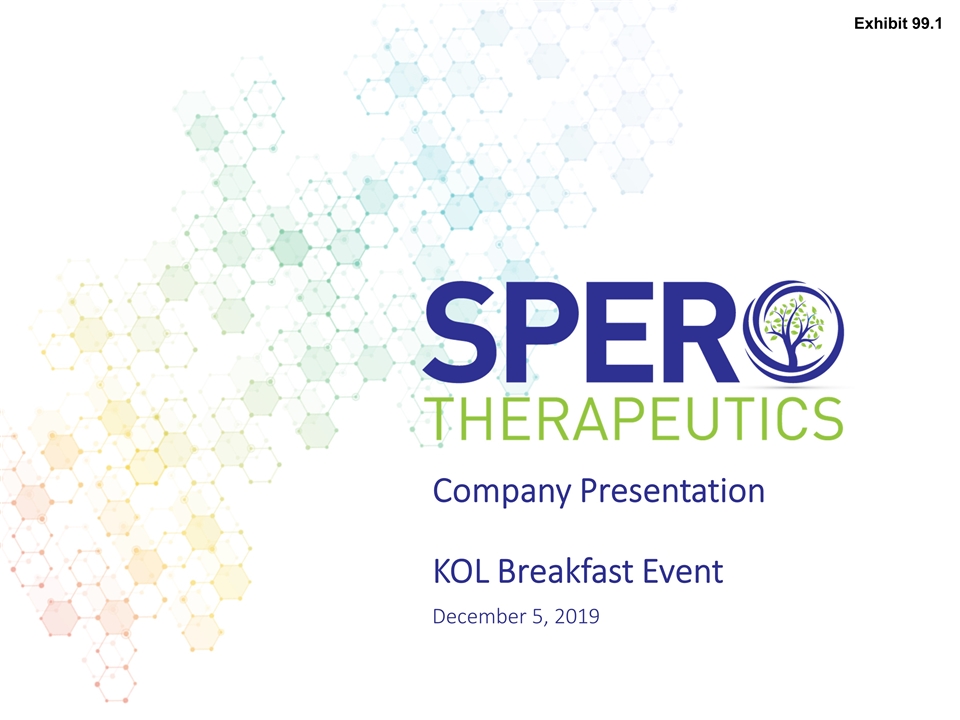
Company Presentation KOL Breakfast Event December 5, 2019 Exhibit 99.1
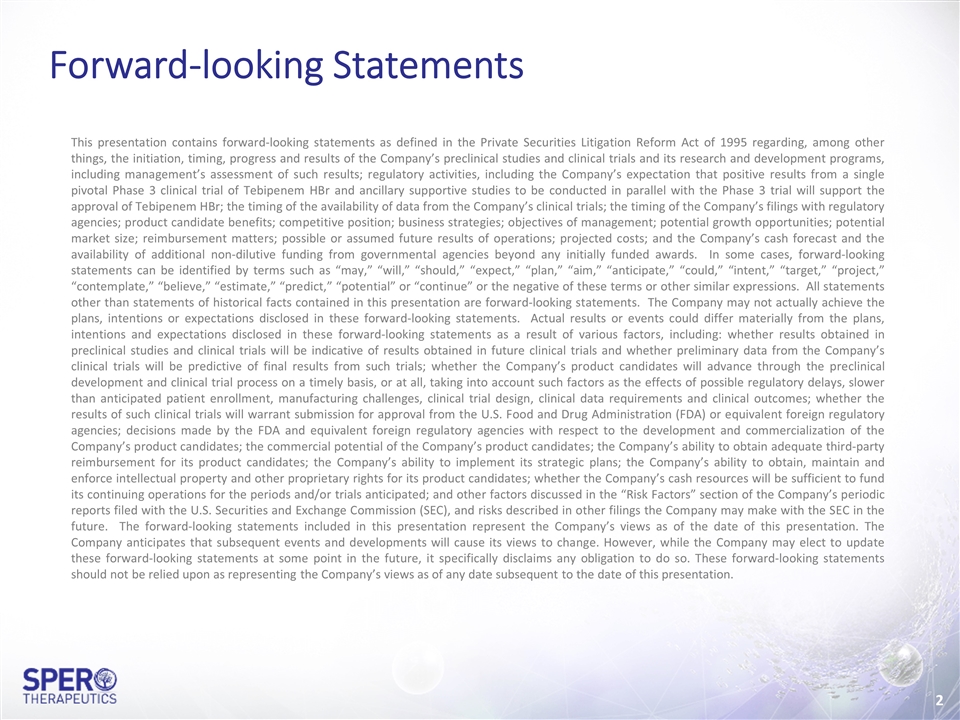
Forward-looking Statements This presentation contains forward-looking statements as defined in the Private Securities Litigation Reform Act of 1995 regarding, among other things, the initiation, timing, progress and results of the Company’s preclinical studies and clinical trials and its research and development programs, including management’s assessment of such results; regulatory activities, including the Company’s expectation that positive results from a single pivotal Phase 3 clinical trial of Tebipenem HBr and ancillary supportive studies to be conducted in parallel with the Phase 3 trial will support the approval of Tebipenem HBr; the timing of the availability of data from the Company’s clinical trials; the timing of the Company’s filings with regulatory agencies; product candidate benefits; competitive position; business strategies; objectives of management; potential growth opportunities; potential market size; reimbursement matters; possible or assumed future results of operations; projected costs; and the Company’s cash forecast and the availability of additional non-dilutive funding from governmental agencies beyond any initially funded awards. In some cases, forward-looking statements can be identified by terms such as “may,” “will,” “should,” “expect,” “plan,” “aim,” “anticipate,” “could,” “intent,” “target,” “project,” “contemplate,” “believe,” “estimate,” “predict,” “potential” or “continue” or the negative of these terms or other similar expressions. All statements other than statements of historical facts contained in this presentation are forward-looking statements. The Company may not actually achieve the plans, intentions or expectations disclosed in these forward-looking statements. Actual results or events could differ materially from the plans, intentions and expectations disclosed in these forward-looking statements as a result of various factors, including: whether results obtained in preclinical studies and clinical trials will be indicative of results obtained in future clinical trials and whether preliminary data from the Company’s clinical trials will be predictive of final results from such trials; whether the Company’s product candidates will advance through the preclinical development and clinical trial process on a timely basis, or at all, taking into account such factors as the effects of possible regulatory delays, slower than anticipated patient enrollment, manufacturing challenges, clinical trial design, clinical data requirements and clinical outcomes; whether the results of such clinical trials will warrant submission for approval from the U.S. Food and Drug Administration (FDA) or equivalent foreign regulatory agencies; decisions made by the FDA and equivalent foreign regulatory agencies with respect to the development and commercialization of the Company’s product candidates; the commercial potential of the Company’s product candidates; the Company’s ability to obtain adequate third-party reimbursement for its product candidates; the Company’s ability to implement its strategic plans; the Company’s ability to obtain, maintain and enforce intellectual property and other proprietary rights for its product candidates; whether the Company’s cash resources will be sufficient to fund its continuing operations for the periods and/or trials anticipated; and other factors discussed in the “Risk Factors” section of the Company’s periodic reports filed with the U.S. Securities and Exchange Commission (SEC), and risks described in other filings the Company may make with the SEC in the future. The forward-looking statements included in this presentation represent the Company’s views as of the date of this presentation. The Company anticipates that subsequent events and developments will cause its views to change. However, while the Company may elect to update these forward-looking statements at some point in the future, it specifically disclaims any obligation to do so. These forward-looking statements should not be relied upon as representing the Company’s views as of any date subsequent to the date of this presentation.
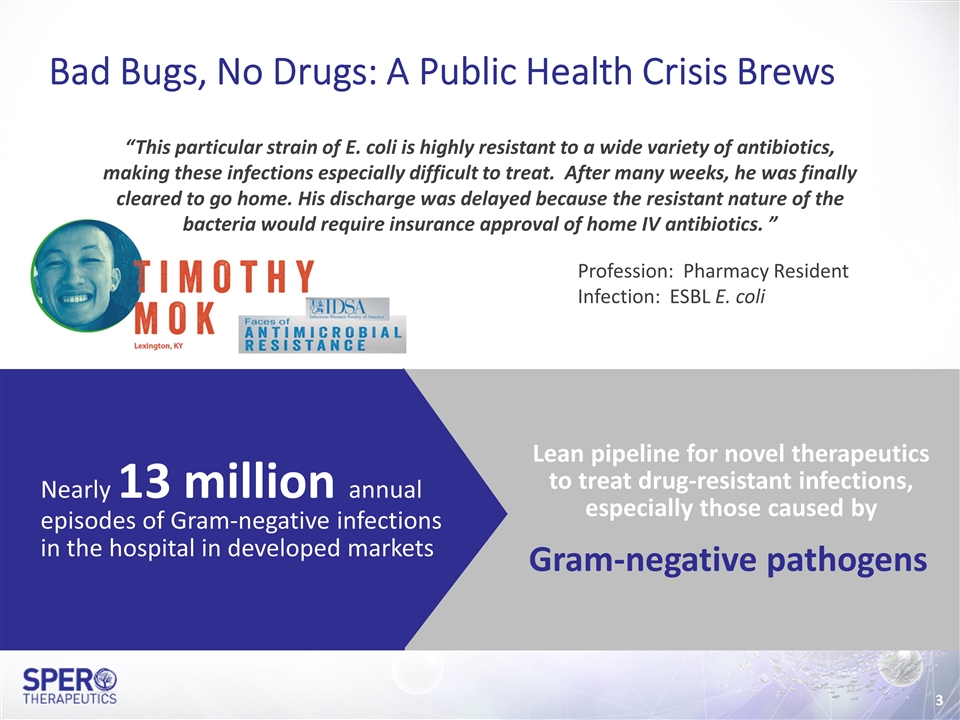
Lean pipeline for novel therapeutics to treat drug-resistant infections, especially those caused by Gram-negative pathogens “This particular strain of E. coli is highly resistant to a wide variety of antibiotics, making these infections especially difficult to treat. After many weeks, he was finally cleared to go home. His discharge was delayed because the resistant nature of the bacteria would require insurance approval of home IV antibiotics. ” Profession: Pharmacy Resident Infection: ESBL E. coli Nearly 13 million annual episodes of Gram-negative infections in the hospital in developed markets Bad Bugs, No Drugs: A Public Health Crisis Brews
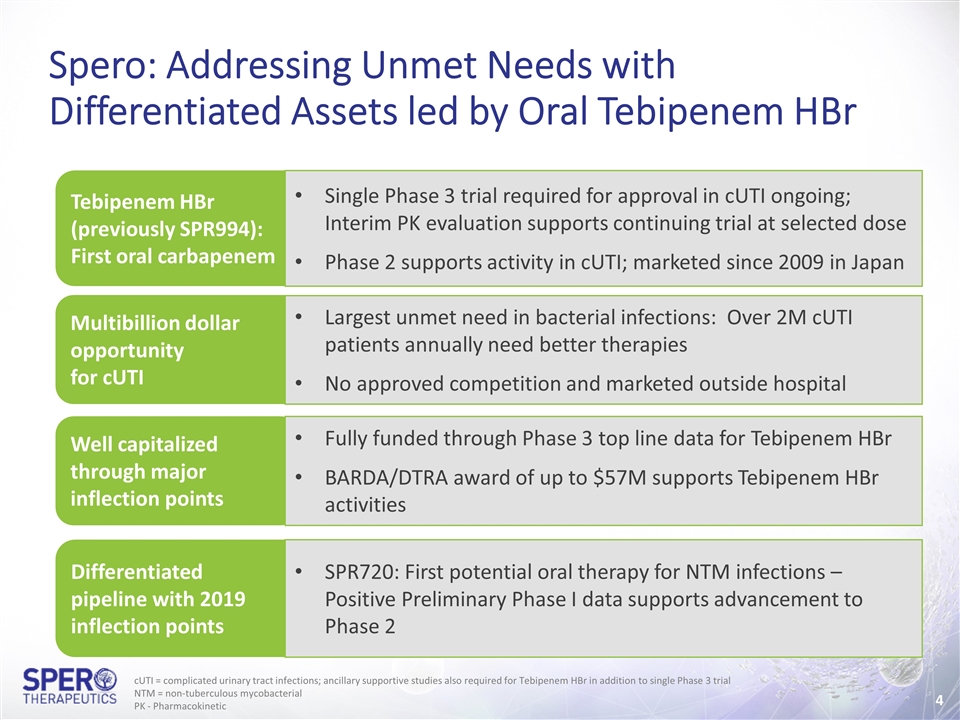
Spero: Addressing Unmet Needs with Differentiated Assets led by Oral Tebipenem HBr Tebipenem HBr (previously SPR994): First oral carbapenem Multibillion dollar opportunity for cUTI Well capitalized through major inflection points Differentiated pipeline with 2019 inflection points Largest unmet need in bacterial infections: Over 2M cUTI patients annually need better therapies No approved competition and marketed outside hospital Fully funded through Phase 3 top line data for Tebipenem HBr BARDA/DTRA award of up to $57M supports Tebipenem HBr activities SPR720: First potential oral therapy for NTM infections – Positive Preliminary Phase I data supports advancement to Phase 2 Single Phase 3 trial required for approval in cUTI ongoing; Interim PK evaluation supports continuing trial at selected dose Phase 2 supports activity in cUTI; marketed since 2009 in Japan cUTI = complicated urinary tract infections; ancillary supportive studies also required for Tebipenem HBr in addition to single Phase 3 trial NTM = non-tuberculous mycobacterial PK - Pharmacokinetic
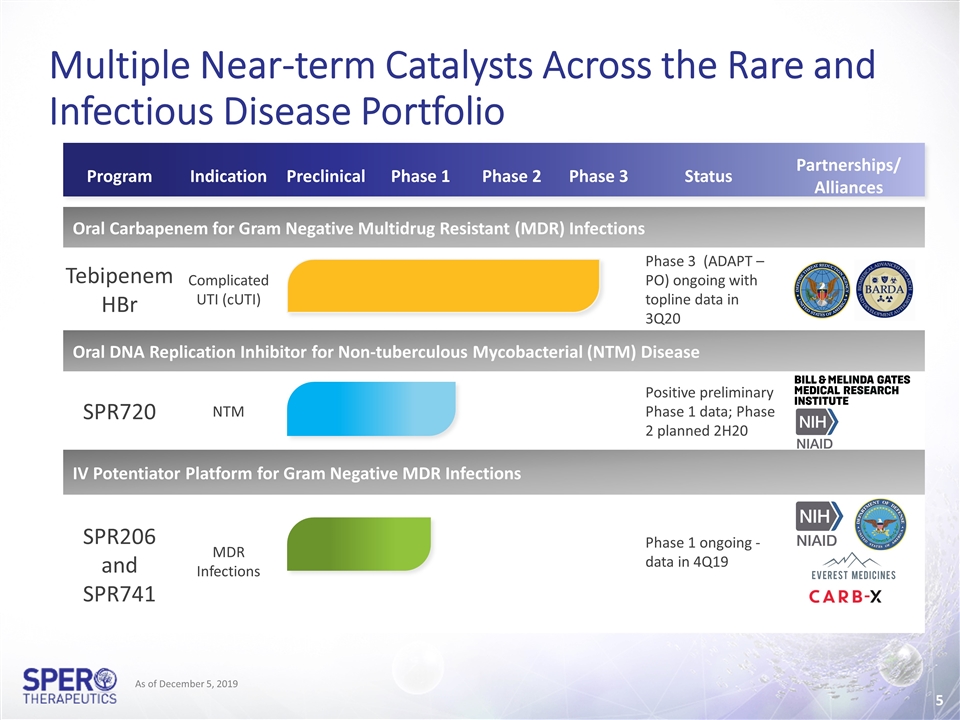
Program Indication Preclinical Phase 1 Phase 2 Phase 3 Status Partnerships/ Alliances Partnerships/ Alliances Oral Carbapenem for Gram Negative Multidrug Resistant (MDR) Infections Tebipenem HBr Complicated UTI (cUTI) Phase 3 (ADAPT – PO) ongoing with topline data in 3Q20 Oral DNA Replication Inhibitor for Non-tuberculous Mycobacterial (NTM) Disease SPR720 NTM Positive preliminary Phase 1 data; Phase 2 planned 2H20 IV Potentiator Platform for Gram Negative MDR Infections SPR206 and SPR741 MDR Infections Phase 1 ongoing - data in 4Q19 Multiple Near-term Catalysts Across the Rare and Infectious Disease Portfolio As of December 5, 2019
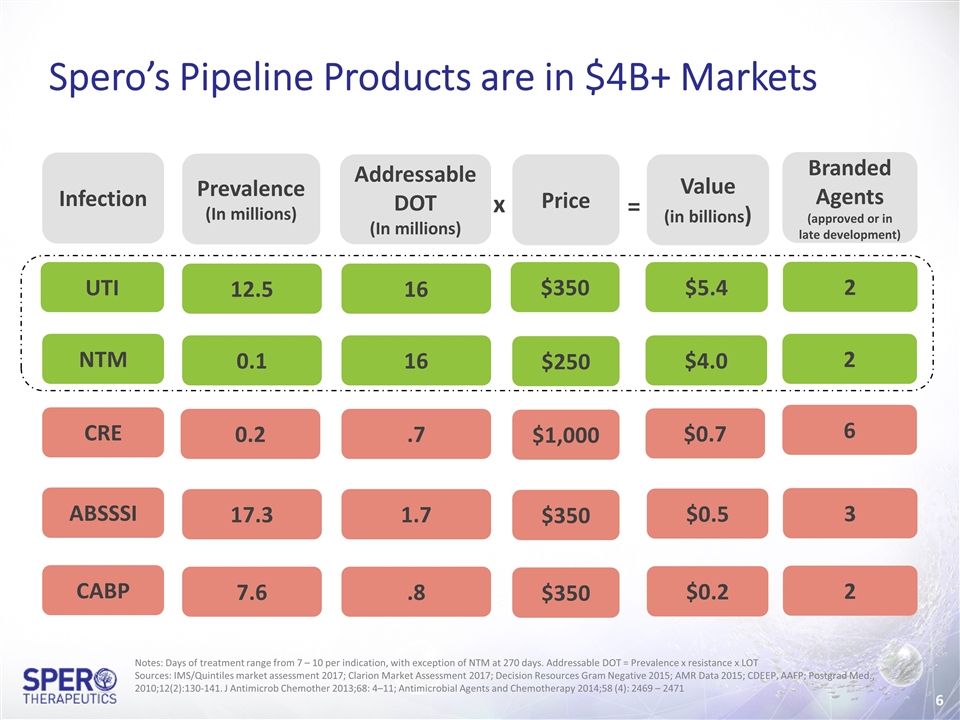
Spero’s Pipeline Products are in $4B+ Markets UTI Infection Prevalence (In millions) Addressable DOT (In millions) Price Value (in billions) ABSSSI CABP NTM CRE 12.5 16 $350 $5.4 17.3 7.6 0.1 0.2 1.7 .8 16 .7 $350 $350 $250 $1,000 $0.5 $0.2 $4.0 $0.7 x = Notes: Days of treatment range from 7 – 10 per indication, with exception of NTM at 270 days. Addressable DOT = Prevalence x resistance x LOT Sources: IMS/Quintiles market assessment 2017; Clarion Market Assessment 2017; Decision Resources Gram Negative 2015; AMR Data 2015; CDEEP, AAFP; Postgrad Med., 2010;12(2):130-141. J Antimicrob Chemother 2013;68: 4–11; Antimicrobial Agents and Chemotherapy 2014;58 (4): 2469 – 2471 Branded Agents (approved or in late development) 2 2 6 3 2
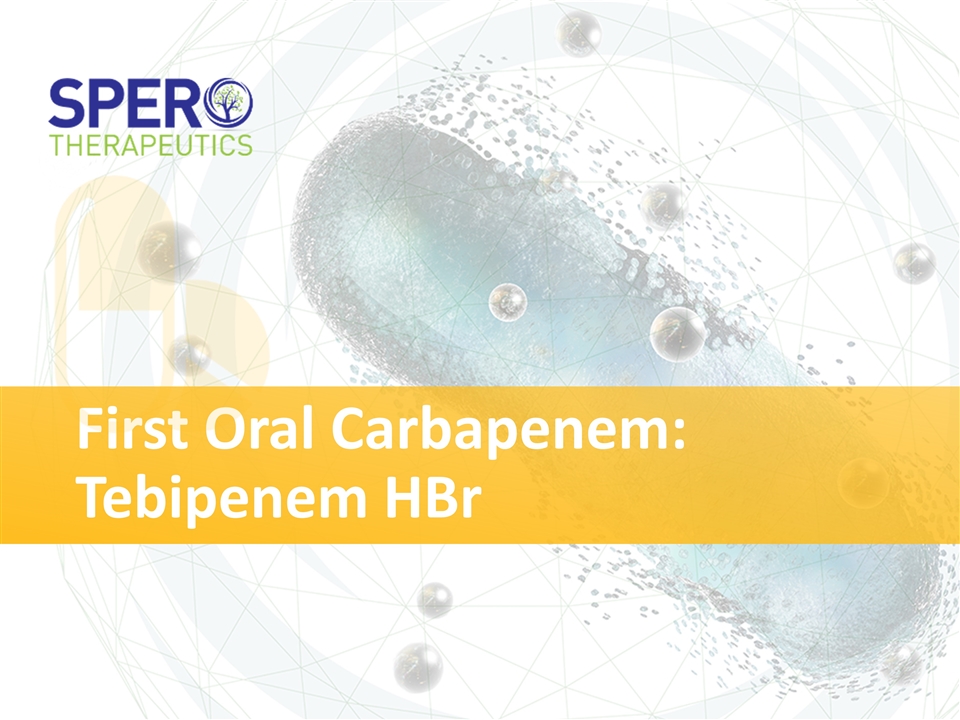
First Oral Carbapenem: Tebipenem HBr
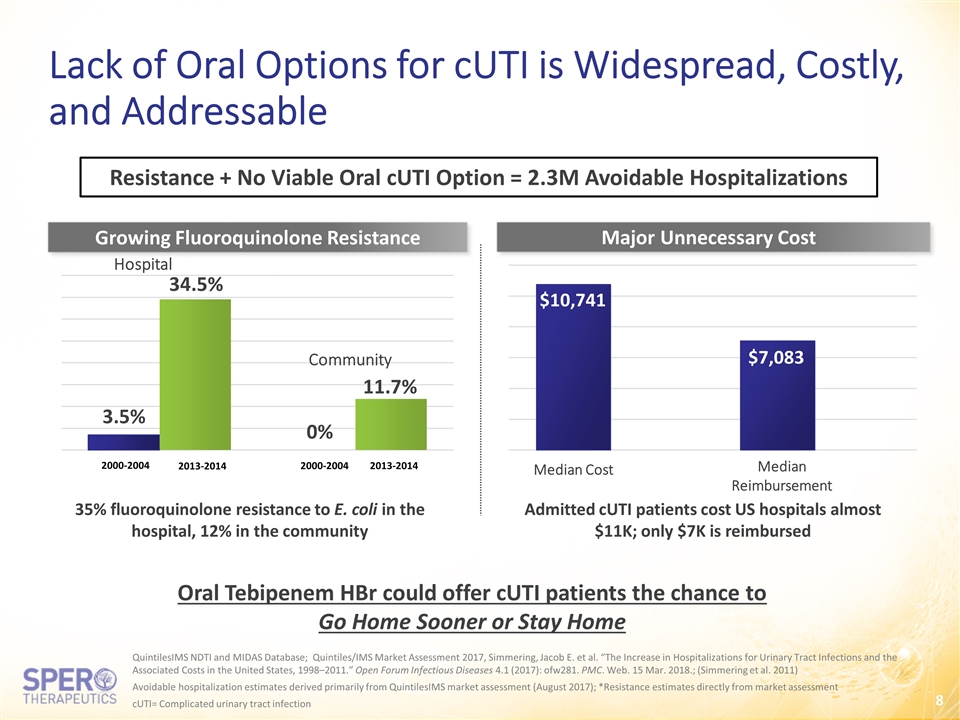
Lack of Oral Options for cUTI is Widespread, Costly, and Addressable QuintilesIMS NDTI and MIDAS Database; Quintiles/IMS Market Assessment 2017, Simmering, Jacob E. et al. “The Increase in Hospitalizations for Urinary Tract Infections and the Associated Costs in the United States, 1998–2011.” Open Forum Infectious Diseases 4.1 (2017): ofw281. PMC. Web. 15 Mar. 2018.; (Simmering et al. 2011) Avoidable hospitalization estimates derived primarily from QuintilesIMS market assessment (August 2017); *Resistance estimates directly from market assessment cUTI= Complicated urinary tract infection Major Unnecessary Cost Growing Fluoroquinolone Resistance 2000-2004 2013-2014 Hospital Community 2000-2004 2013-2014 35% fluoroquinolone resistance to E. coli in the hospital, 12% in the community Median Cost Median Reimbursement Admitted cUTI patients cost US hospitals almost $11K; only $7K is reimbursed $10,741 $7,083 Oral Tebipenem HBr could offer cUTI patients the chance to Go Home Sooner or Stay Home Resistance + No Viable Oral cUTI Option = 2.3M Avoidable Hospitalizations
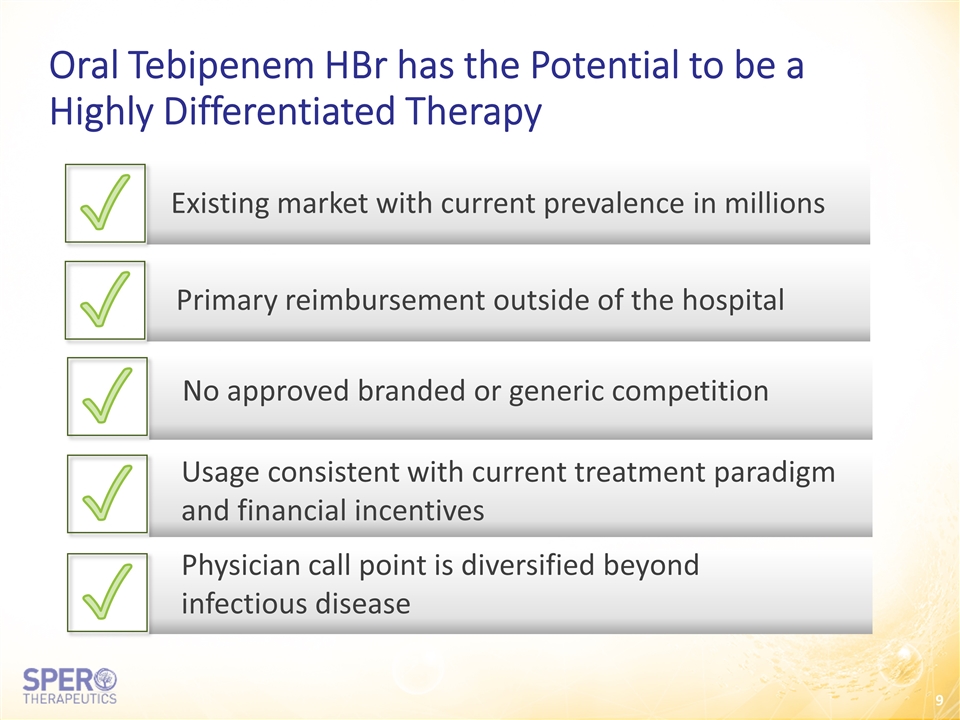
Oral Tebipenem HBr has the Potential to be a Highly Differentiated Therapy ✓ Primary reimbursement outside of the hospital Physician call point is diversified beyond infectious disease Usage consistent with current treatment paradigm and financial incentives No approved branded or generic competition ✓ ✓ ✓ ✓ Existing market with current prevalence in millions
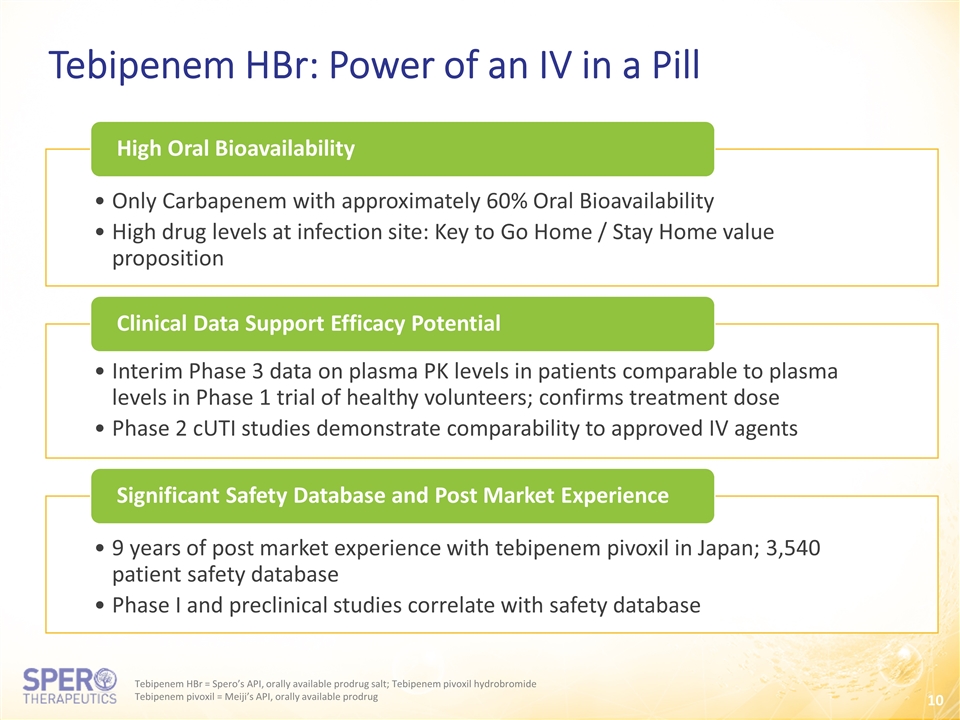
Tebipenem HBr: Power of an IV in a Pill Tebipenem HBr = Spero’s API, orally available prodrug salt; Tebipenem pivoxil hydrobromide Tebipenem pivoxil = Meiji’s API, orally available prodrug High Oral Bioavailability Only Carbapenem with approximately 60% Oral Bioavailability High drug levels at infection site: Key to Go Home / Stay Home value proposition Clinical Data Support Efficacy Potential Interim Phase 3 data on plasma PK levels in patients comparable to plasma levels in Phase 1 trial of healthy volunteers; confirms treatment dose Phase 2 cUTI studies demonstrate comparability to approved IV agents Significant Safety Database and Post Market Experience 9 years of post market experience with tebipenem pivoxil in Japan; 3,540 patient safety database Phase I and preclinical studies correlate with safety database
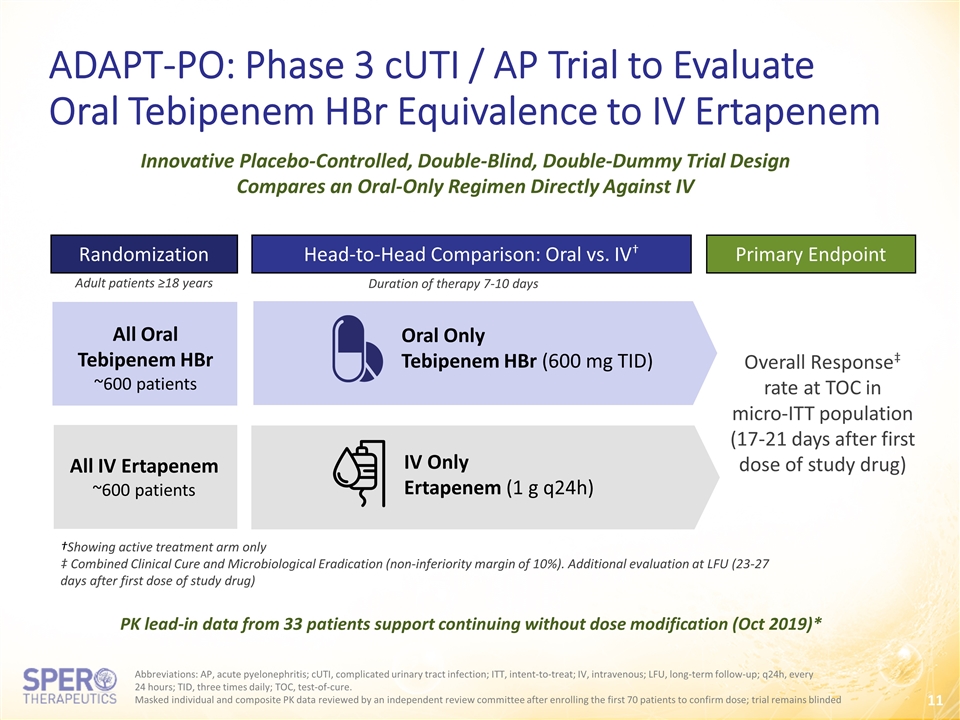
ADAPT-PO: Phase 3 cUTI / AP Trial to Evaluate Oral Tebipenem HBr Equivalence to IV Ertapenem Randomization All Oral Tebipenem HBr ~600 patients All IV Ertapenem ~600 patients Primary Endpoint Overall Response‡ rate at TOC in micro-ITT population (17-21 days after first dose of study drug) Head-to-Head Comparison: Oral vs. IV† Oral Only Tebipenem HBr (600 mg TID) IV Only Ertapenem (1 g q24h) Duration of therapy 7-10 days Adult patients ≥18 years Abbreviations: AP, acute pyelonephritis; cUTI, complicated urinary tract infection; ITT, intent-to-treat; IV, intravenous; LFU, long-term follow-up; q24h, every 24 hours; TID, three times daily; TOC, test-of-cure. Masked individual and composite PK data reviewed by an independent review committee after enrolling the first 70 patients to confirm dose; trial remains blinded Innovative Placebo-Controlled, Double-Blind, Double-Dummy Trial Design Compares an Oral-Only Regimen Directly Against IV †Showing active treatment arm only ‡ Combined Clinical Cure and Microbiological Eradication (non-inferiority margin of 10%). Additional evaluation at LFU (23-27 days after first dose of study drug) PK lead-in data from 33 patients support continuing without dose modification (Oct 2019)*
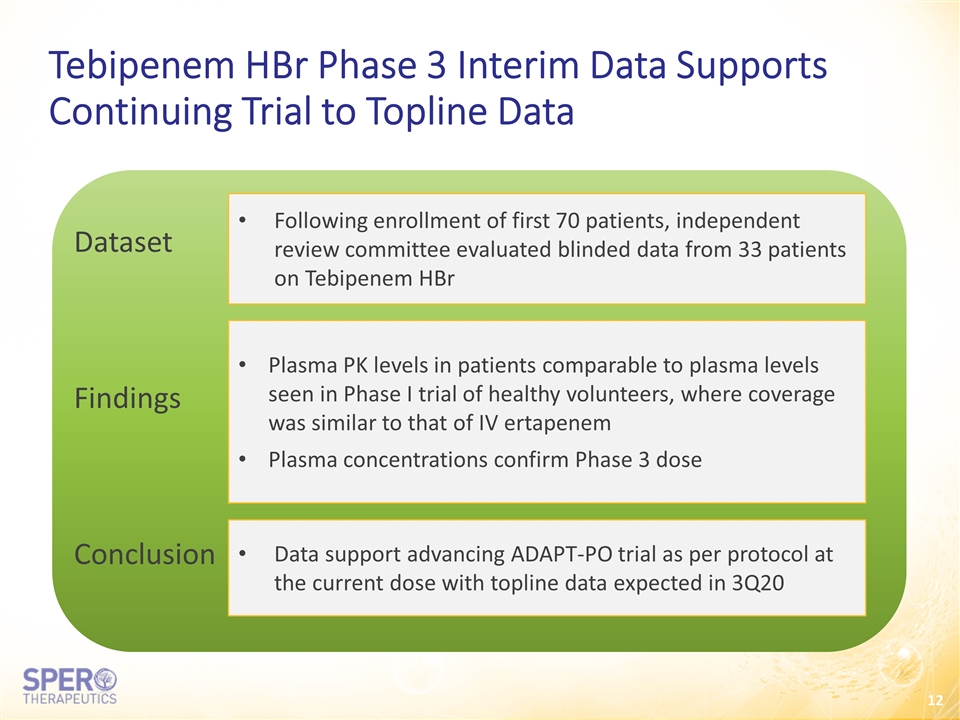
Tebipenem HBr Phase 3 Interim Data Supports Continuing Trial to Topline Data Following enrollment of first 70 patients, independent review committee evaluated blinded data from 33 patients on Tebipenem HBr Plasma PK levels in patients comparable to plasma levels seen in Phase I trial of healthy volunteers, where coverage was similar to that of IV ertapenem Plasma concentrations confirm Phase 3 dose Data support advancing ADAPT-PO trial as per protocol at the current dose with topline data expected in 3Q20 Dataset Conclusion Findings
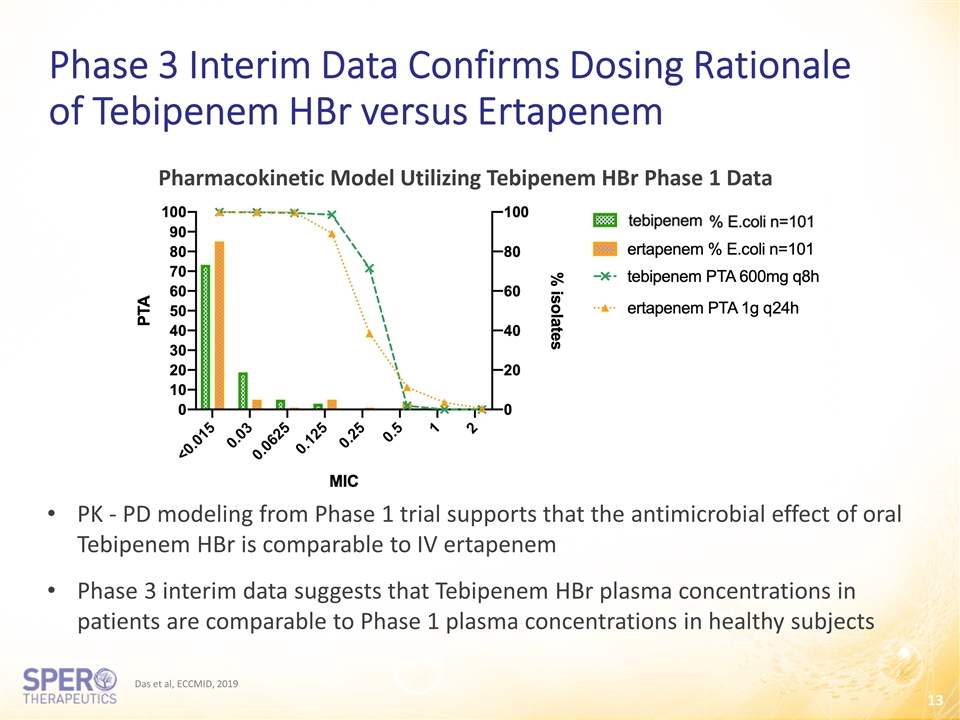
Phase 3 Interim Data Confirms Dosing Rationale of Tebipenem HBr versus Ertapenem Das et al, ECCMID, 2019 PK - PD modeling from Phase 1 trial supports that the antimicrobial effect of oral Tebipenem HBr is comparable to IV ertapenem Phase 3 interim data suggests that Tebipenem HBr plasma concentrations in patients are comparable to Phase 1 plasma concentrations in healthy subjects Pharmacokinetic Model Utilizing Tebipenem HBr Phase 1 Data
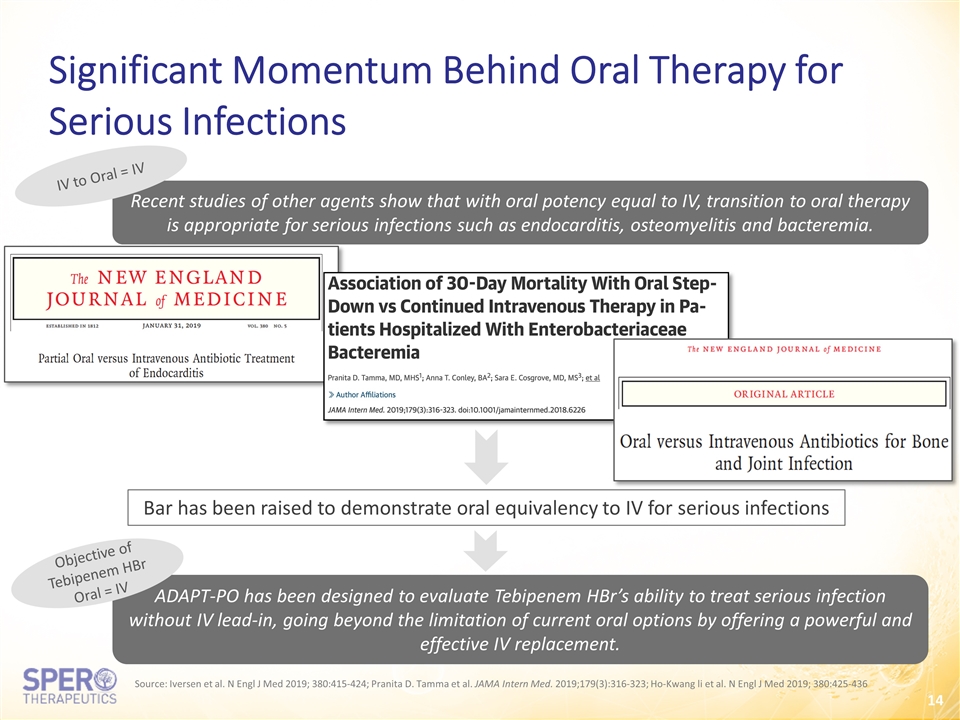
Bar has been raised to demonstrate oral equivalency to IV for serious infections Recent studies of other agents show that with oral potency equal to IV, transition to oral therapy is appropriate for serious infections such as endocarditis, osteomyelitis and bacteremia. ADAPT-PO has been designed to evaluate Tebipenem HBr’s ability to treat serious infection without IV lead-in, going beyond the limitation of current oral options by offering a powerful and effective IV replacement. IV to Oral = IV Objective of Tebipenem HBr Oral = IV Significant Momentum Behind Oral Therapy for Serious Infections Source: Iversen et al. N Engl J Med 2019; 380:415-424; Pranita D. Tamma et al. JAMA Intern Med. 2019;179(3):316-323; Ho-Kwang li et al. N Engl J Med 2019; 380:425-436
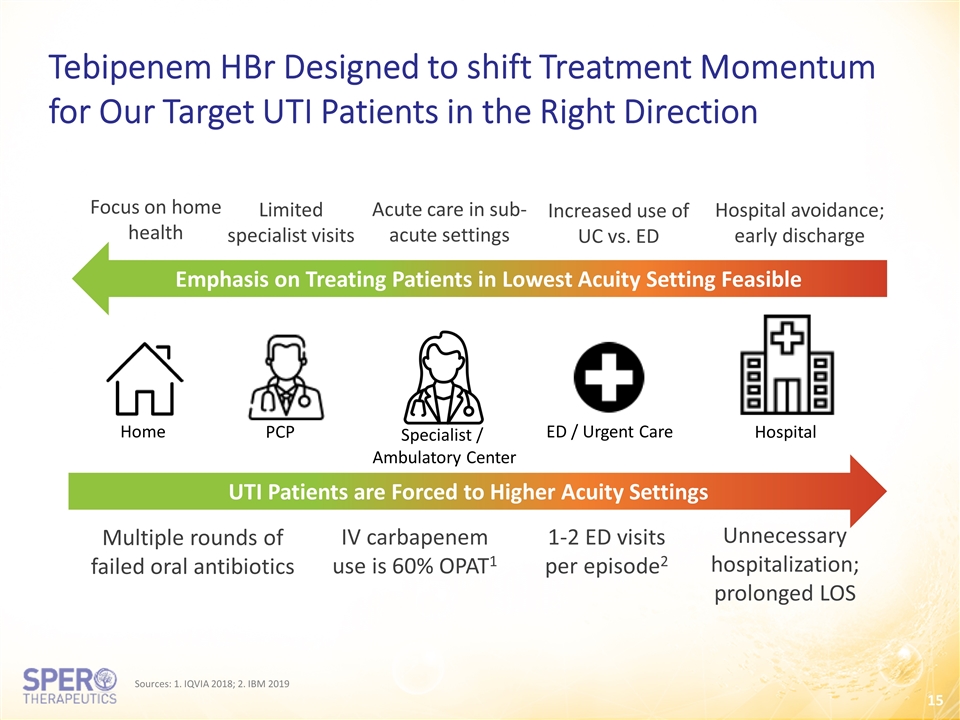
Tebipenem HBr Designed to shift Treatment Momentum for Our Target UTI Patients in the Right Direction Hospital ED / Urgent Care PCP Home Multiple rounds of failed oral antibiotics 1-2 ED visits per episode2 Focus on home health Limited specialist visits Hospital avoidance; early discharge Unnecessary hospitalization; prolonged LOS Emphasis on Treating Patients in Lowest Acuity Setting Feasible IV carbapenem use is 60% OPAT1 UTI Patients are Forced to Higher Acuity Settings Specialist / Ambulatory Center Increased use of UC vs. ED Acute care in sub-acute settings Sources: 1. IQVIA 2018; 2. IBM 2019
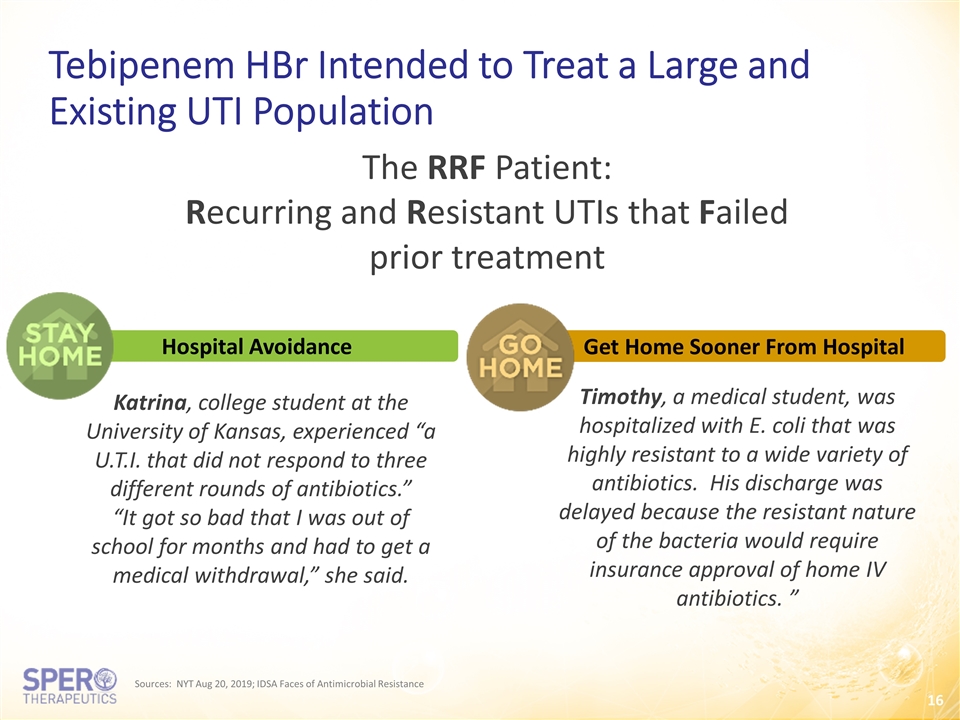
Get Home Sooner From Hospital Hospital Avoidance Tebipenem HBr Intended to Treat a Large and Existing UTI Population Katrina, college student at the University of Kansas, experienced “a U.T.I. that did not respond to three different rounds of antibiotics.” “It got so bad that I was out of school for months and had to get a medical withdrawal,” she said. Timothy, a medical student, was hospitalized with E. coli that was highly resistant to a wide variety of antibiotics. His discharge was delayed because the resistant nature of the bacteria would require insurance approval of home IV antibiotics. ” The RRF Patient: Recurring and Resistant UTIs that Failed prior treatment Sources: NYT Aug 20, 2019; IDSA Faces of Antimicrobial Resistance
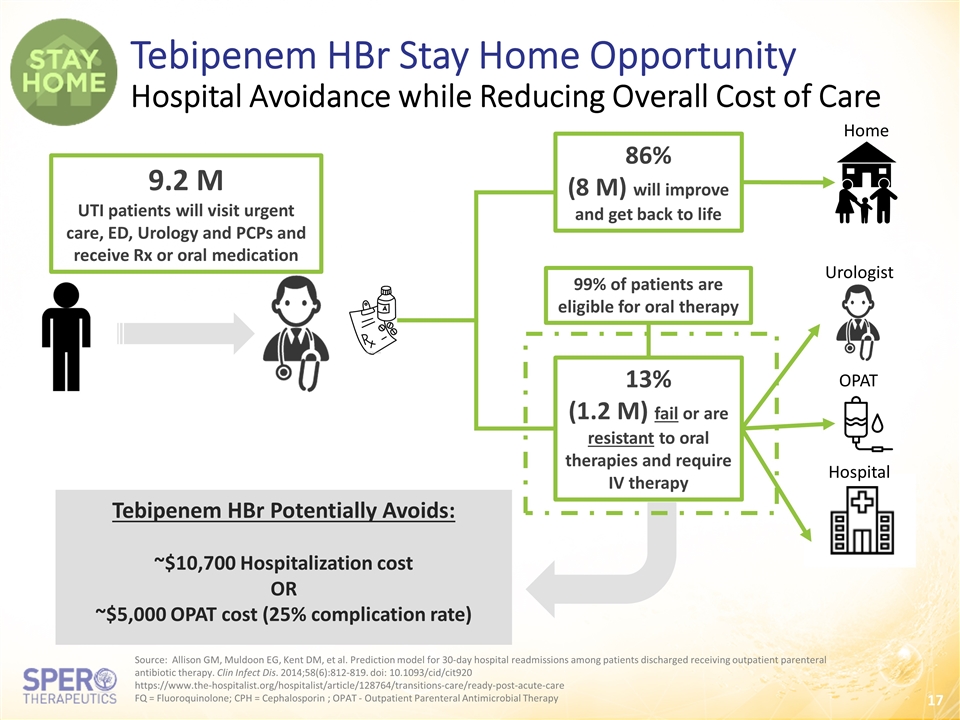
9.2 M UTI patients will visit urgent care, ED, Urology and PCPs and receive Rx or oral medication 86% (8 M) will improve and get back to life 13% (1.2 M) fail or are resistant to oral therapies and require IV therapy Tebipenem HBr Potentially Avoids: ~$10,700 Hospitalization cost OR ~$5,000 OPAT cost (25% complication rate) Tebipenem HBr Stay Home Opportunity Hospital Avoidance while Reducing Overall Cost of Care Source: Allison GM, Muldoon EG, Kent DM, et al. Prediction model for 30-day hospital readmissions among patients discharged receiving outpatient parenteral antibiotic therapy. Clin Infect Dis. 2014;58(6):812-819. doi: 10.1093/cid/cit920 https://www.the-hospitalist.org/hospitalist/article/128764/transitions-care/ready-post-acute-care FQ = Fluoroquinolone; CPH = Cephalosporin ; OPAT - Outpatient Parenteral Antimicrobial Therapy Home Urologist OPAT Hospital 99% of patients are eligible for oral therapy
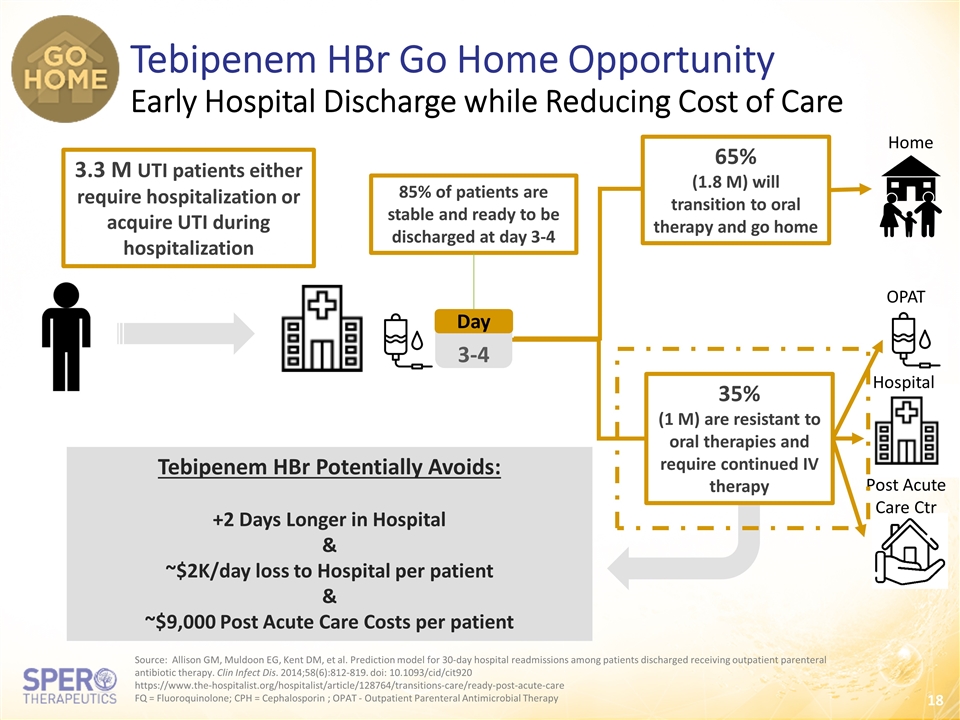
65% (1.8 M) will transition to oral therapy and go home 3.3 M UTI patients either require hospitalization or acquire UTI during hospitalization 3-4 Day 85% of patients are stable and ready to be discharged at day 3-4 Tebipenem HBr Potentially Avoids: +2 Days Longer in Hospital & ~$2K/day loss to Hospital per patient & ~$9,000 Post Acute Care Costs per patient Tebipenem HBr Go Home Opportunity Early Hospital Discharge while Reducing Cost of Care Source: Allison GM, Muldoon EG, Kent DM, et al. Prediction model for 30-day hospital readmissions among patients discharged receiving outpatient parenteral antibiotic therapy. Clin Infect Dis. 2014;58(6):812-819. doi: 10.1093/cid/cit920 https://www.the-hospitalist.org/hospitalist/article/128764/transitions-care/ready-post-acute-care FQ = Fluoroquinolone; CPH = Cephalosporin ; OPAT - Outpatient Parenteral Antimicrobial Therapy Home OPAT Hospital Post Acute Care Ctr 35% (1 M) are resistant to oral therapies and require continued IV therapy
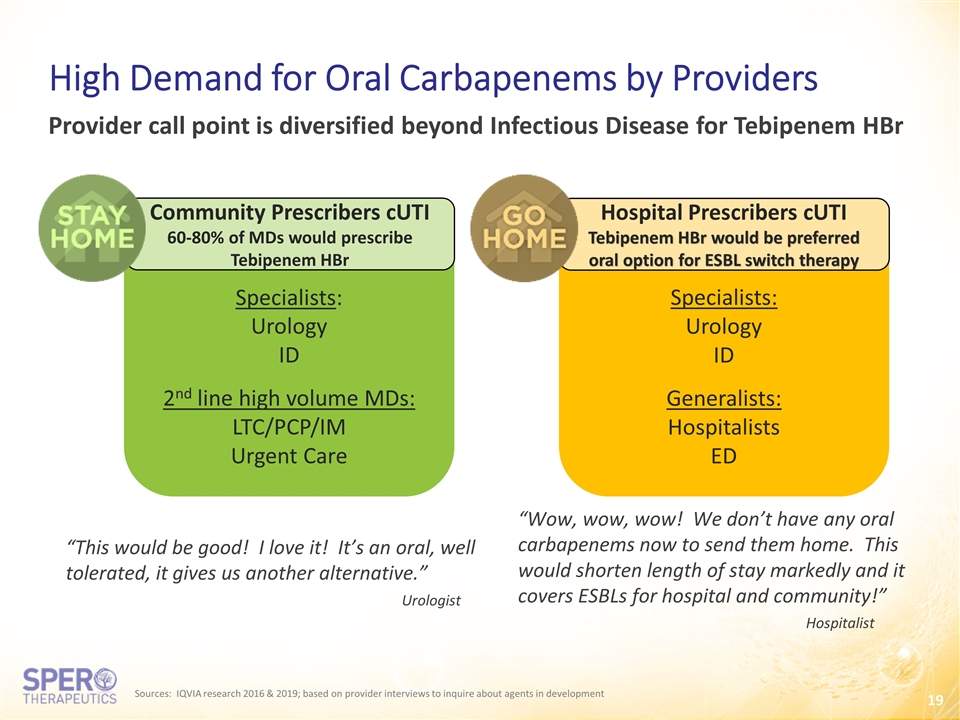
High Demand for Oral Carbapenems by Providers Specialists: Urology ID 2nd line high volume MDs: LTC/PCP/IM Urgent Care Specialists: Urology ID Generalists: Hospitalists ED Community Prescribers cUTI 60-80% of MDs would prescribe Tebipenem HBr Hospital Prescribers cUTI Tebipenem HBr would be preferred oral option for ESBL switch therapy “Wow, wow, wow! We don’t have any oral carbapenems now to send them home. This would shorten length of stay markedly and it covers ESBLs for hospital and community!” Hospitalist “This would be good! I love it! It’s an oral, well tolerated, it gives us another alternative.” Urologist Sources: IQVIA research 2016 & 2019; based on provider interviews to inquire about agents in development Provider call point is diversified beyond Infectious Disease for Tebipenem HBr
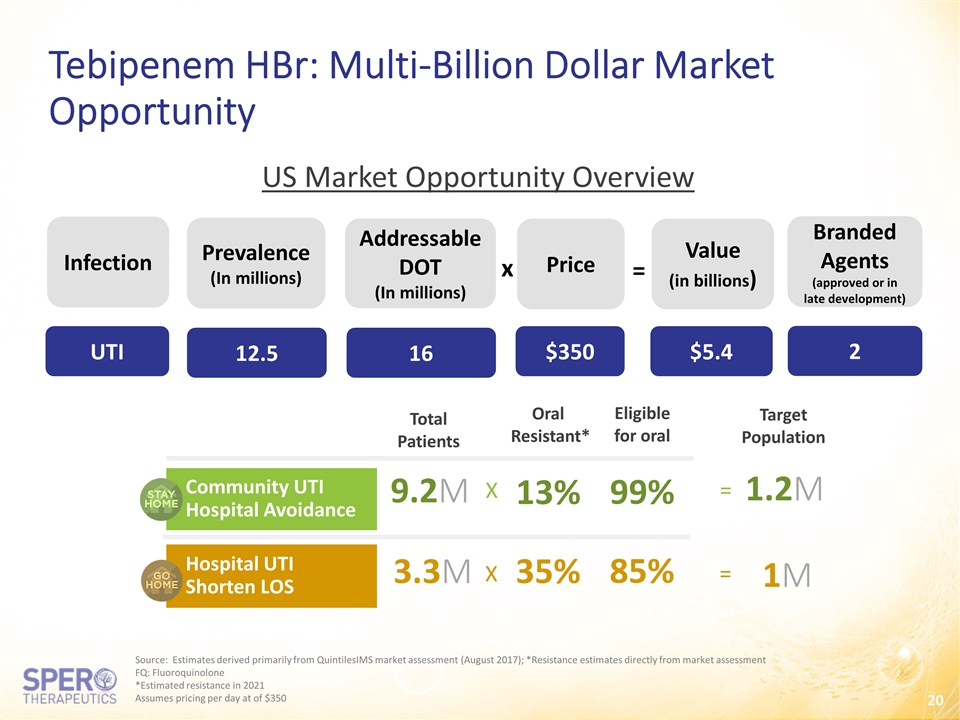
Hospital UTI Shorten LOS Tebipenem HBr: Multi-Billion Dollar Market Opportunity Community UTI Hospital Avoidance Source: Estimates derived primarily from QuintilesIMS market assessment (August 2017); *Resistance estimates directly from market assessment FQ: Fluoroquinolone *Estimated resistance in 2021 Assumes pricing per day at of $350 Oral Resistant* 13% 35% Total Patients 9.2M 3.3M US Market Opportunity Overview X X Target Population 1.2M 1M = = UTI Infection Prevalence (In millions) Addressable DOT (In millions) Price Value (in billions) 12.5 16 $350 $5.4 x = Branded Agents (approved or in late development) 2 99% 85% Eligible for oral
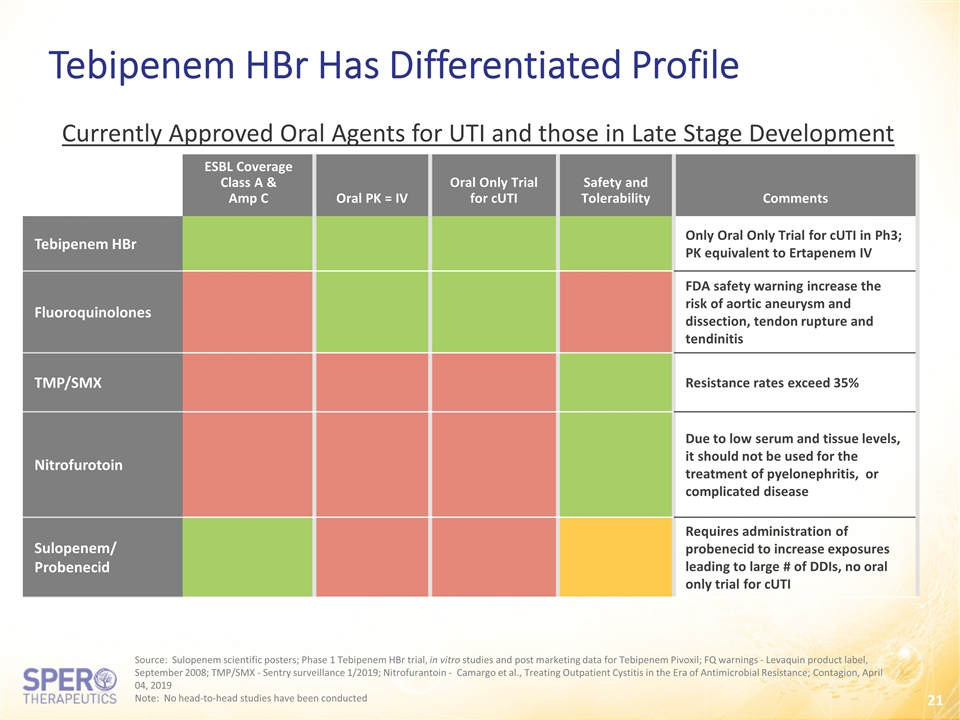
Tebipenem HBr Has Differentiated Profile Source: Sulopenem scientific posters; Phase 1 Tebipenem HBr trial, in vitro studies and post marketing data for Tebipenem Pivoxil; FQ warnings - Levaquin product label, September 2008; TMP/SMX - Sentry surveillance 1/2019; Nitrofurantoin - Camargo et al., Treating Outpatient Cystitis in the Era of Antimicrobial Resistance; Contagion, April 04, 2019 Note: No head-to-head studies have been conducted Currently Approved Oral Agents for UTI and those in Late Stage Development ESBL Coverage Class A & Amp C Oral PK = IV Oral Only Trial for cUTI Safety and Tolerability Comments Tebipenem HBr Only Oral Only Trial for cUTI in Ph3; PK equivalent to Ertapenem IV Fluoroquinolones FDA safety warning increase the risk of aortic aneurysm and dissection, tendon rupture and tendinitis TMP/SMX Resistance rates exceed 35% Nitrofurotoin Due to low serum and tissue levels, it should not be used for the treatment of pyelonephritis, or complicated disease Sulopenem/ Probenecid Requires administration of probenecid to increase exposures leading to large # of DDIs, no oral only trial for cUTI
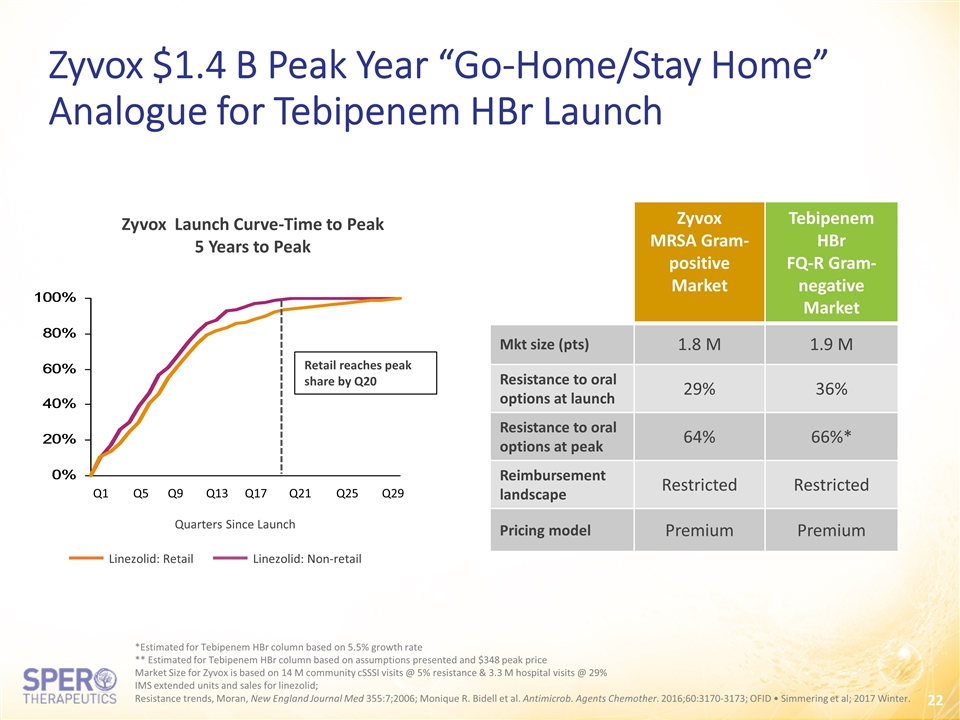
Zyvox $1.4 B Peak Year “Go-Home/Stay Home” Analogue for Tebipenem HBr Launch Zyvox MRSA Gram-positive Market Tebipenem HBr FQ-R Gram-negative Market Mkt size (pts) 1.8 M 1.9 M Resistance to oral options at launch 29% 36% Resistance to oral options at peak 64% 66%* Reimbursement landscape Restricted Restricted Pricing model Premium Premium Zyvox Launch Curve-Time to Peak 5 Years to Peak *Estimated for Tebipenem HBr column based on 5.5% growth rate ** Estimated for Tebipenem HBr column based on assumptions presented and $348 peak price Market Size for Zyvox is based on 14 M community cSSSI visits @ 5% resistance & 3.3 M hospital visits @ 29% IMS extended units and sales for linezolid; Resistance trends, Moran, New England Journal Med 355:7;2006; Monique R. Bidell et al. Antimicrob. Agents Chemother. 2016;60:3170-3173; OFID • Simmering et al; 2017 Winter. Retail reaches peak share by Q20 Quarters Since Launch
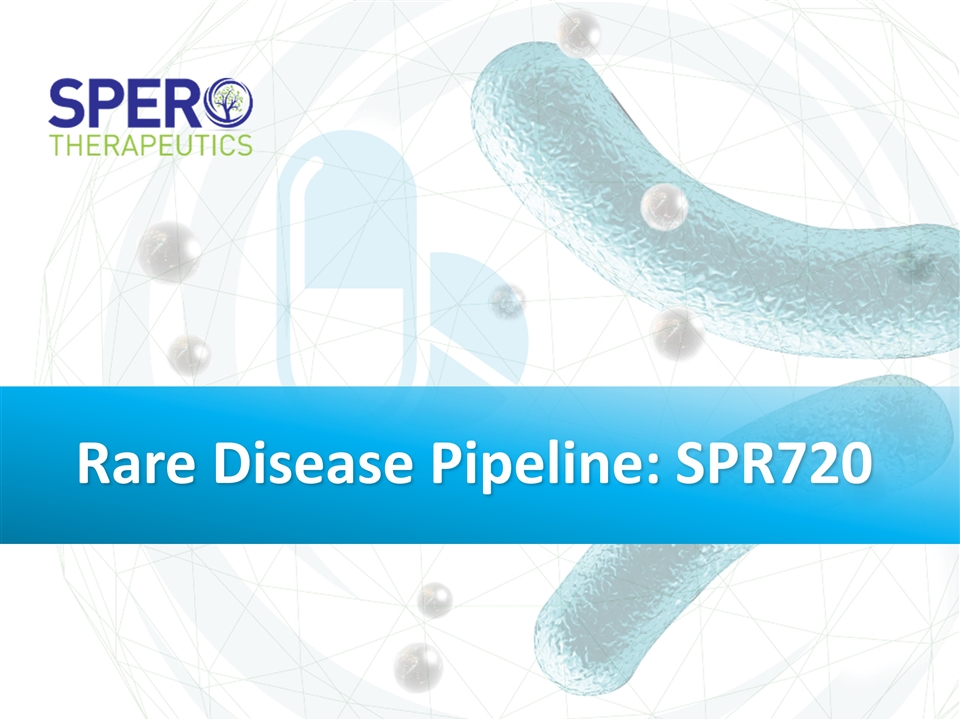
Rare Disease Pipeline: SPR720
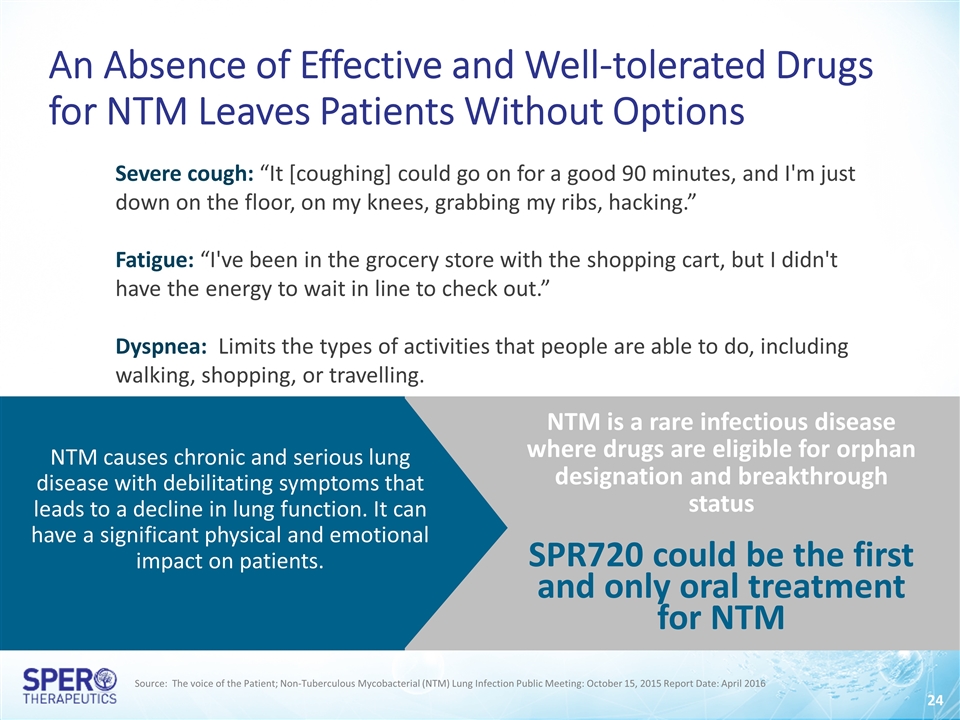
NTM is a rare infectious disease where drugs are eligible for orphan designation and breakthrough status SPR720 could be the first and only oral treatment for NTM Severe cough: “It [coughing] could go on for a good 90 minutes, and I'm just down on the floor, on my knees, grabbing my ribs, hacking.” Fatigue: “I've been in the grocery store with the shopping cart, but I didn't have the energy to wait in line to check out.” Dyspnea: Limits the types of activities that people are able to do, including walking, shopping, or travelling. NTM causes chronic and serious lung disease with debilitating symptoms that leads to a decline in lung function. It can have a significant physical and emotional impact on patients. Source: The voice of the Patient; Non-Tuberculous Mycobacterial (NTM) Lung Infection Public Meeting: October 15, 2015 Report Date: April 2016 An Absence of Effective and Well-tolerated Drugs for NTM Leaves Patients Without Options
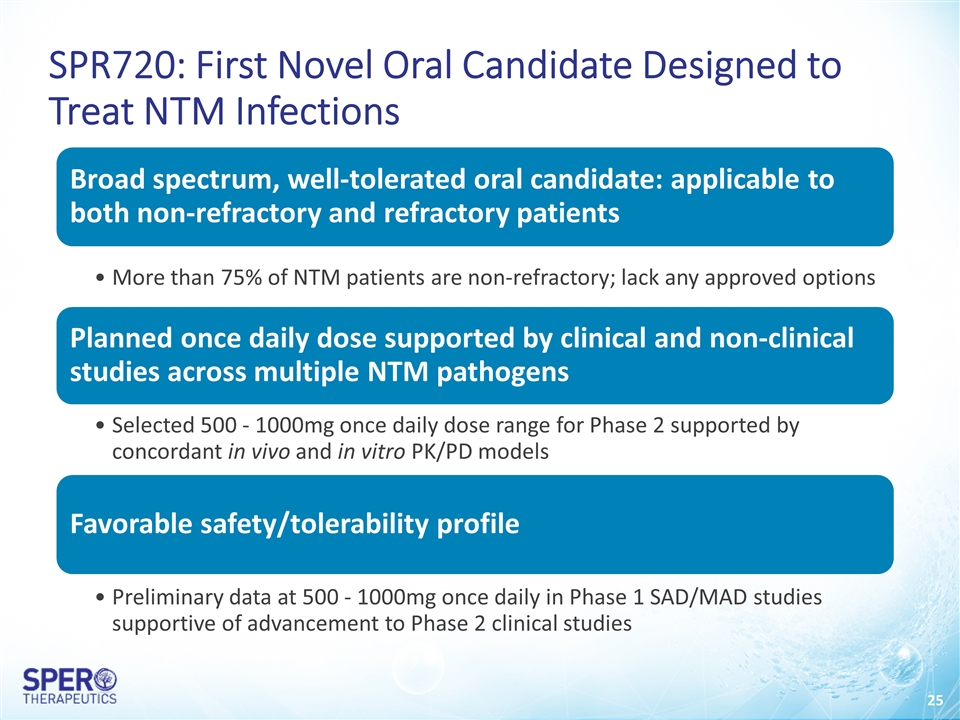
SPR720: First Novel Oral Candidate Designed to Treat NTM Infections Broad spectrum, well-tolerated oral candidate: applicable to both non-refractory and refractory patients More than 75% of NTM patients are non-refractory; lack any approved options Planned once daily dose supported by clinical and non-clinical studies across multiple NTM pathogens Selected 500 - 1000mg once daily dose range for Phase 2 supported by concordant in vivo and in vitro PK/PD models Favorable safety/tolerability profile Preliminary data at 500 - 1000mg once daily in Phase 1 SAD/MAD studies supportive of advancement to Phase 2 clinical studies
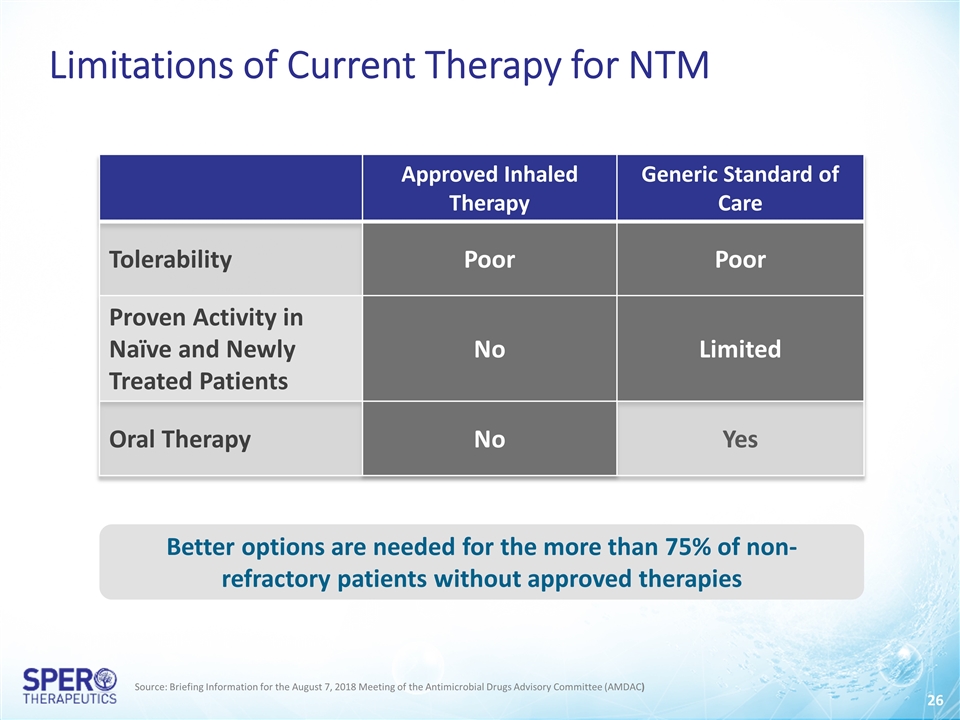
Limitations of Current Therapy for NTM Approved Inhaled Therapy Generic Standard of Care Tolerability Poor Poor Proven Activity in Naïve and Newly Treated Patients No Limited Oral Therapy No Yes Source: Briefing Information for the August 7, 2018 Meeting of the Antimicrobial Drugs Advisory Committee (AMDAC) Better options are needed for the more than 75% of non-refractory patients without approved therapies
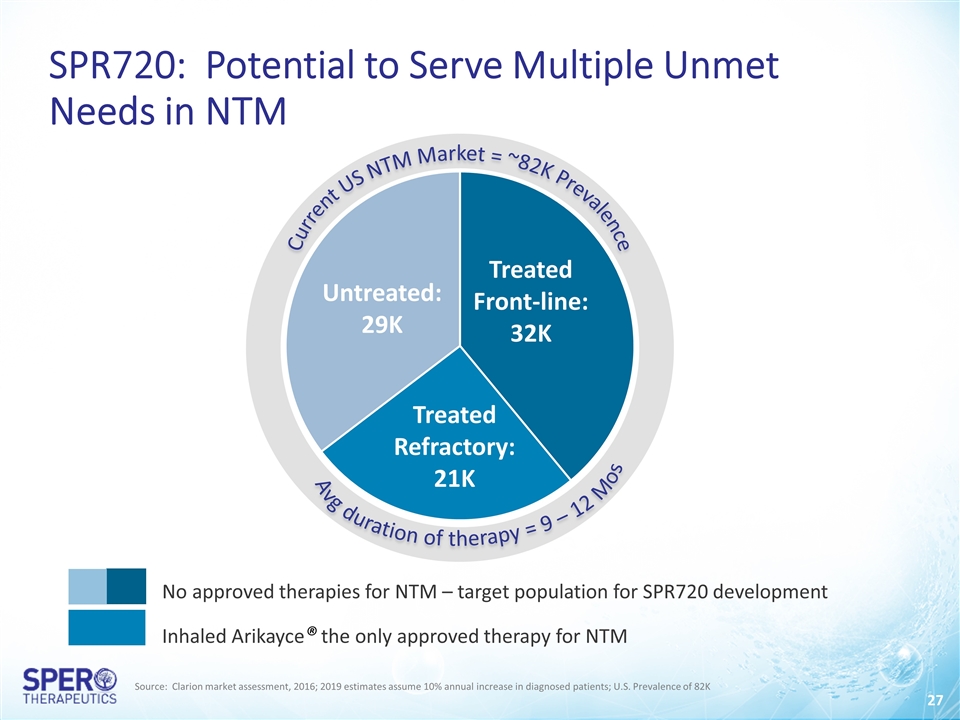
Source: Clarion market assessment, 2016; 2019 estimates assume 10% annual increase in diagnosed patients; U.S. Prevalence of 82K SPR720: Potential to Serve Multiple Unmet Needs in NTM Untreated: 29K Treated Front-line: 32K Treated Refractory: 21K Current US NTM Market = ~82K Prevalence Avg duration of therapy = 9 – 12 Mos No approved therapies for NTM – target population for SPR720 development Inhaled Arikayce® the only approved therapy for NTM
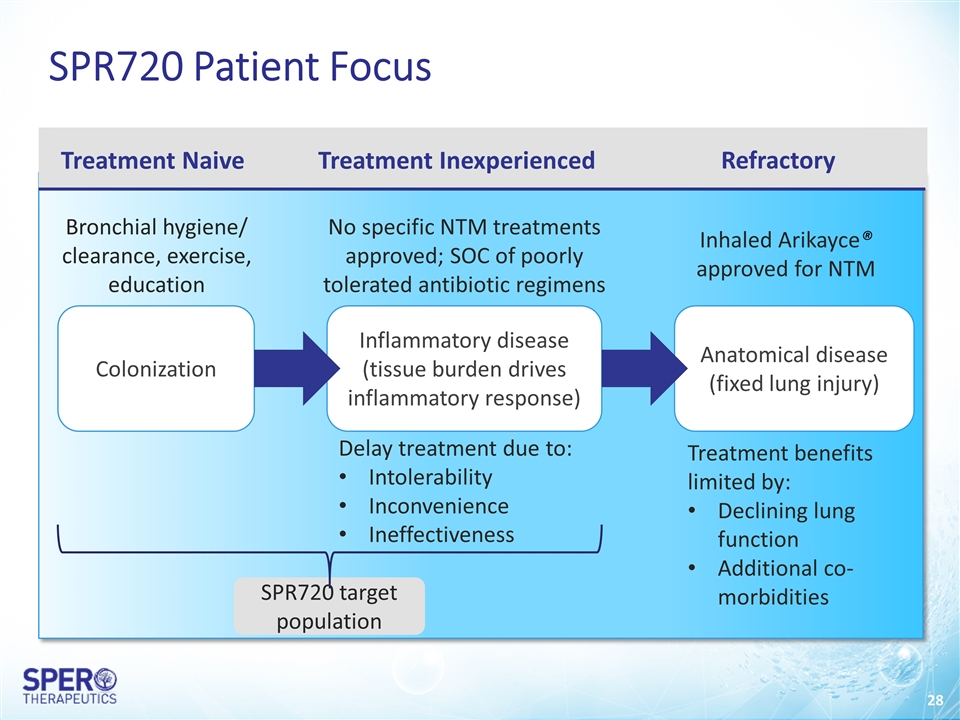
Colonization Inflammatory disease (tissue burden drives inflammatory response) Anatomical disease (fixed lung injury) Treatment Naive Treatment Inexperienced Refractory Treatment benefits limited by: Declining lung function Additional co-morbidities Delay treatment due to: Intolerability Inconvenience Ineffectiveness Bronchial hygiene/ clearance, exercise, education No specific NTM treatments approved; SOC of poorly tolerated antibiotic regimens Inhaled Arikayce® approved for NTM SPR720 target population SPR720 Patient Focus
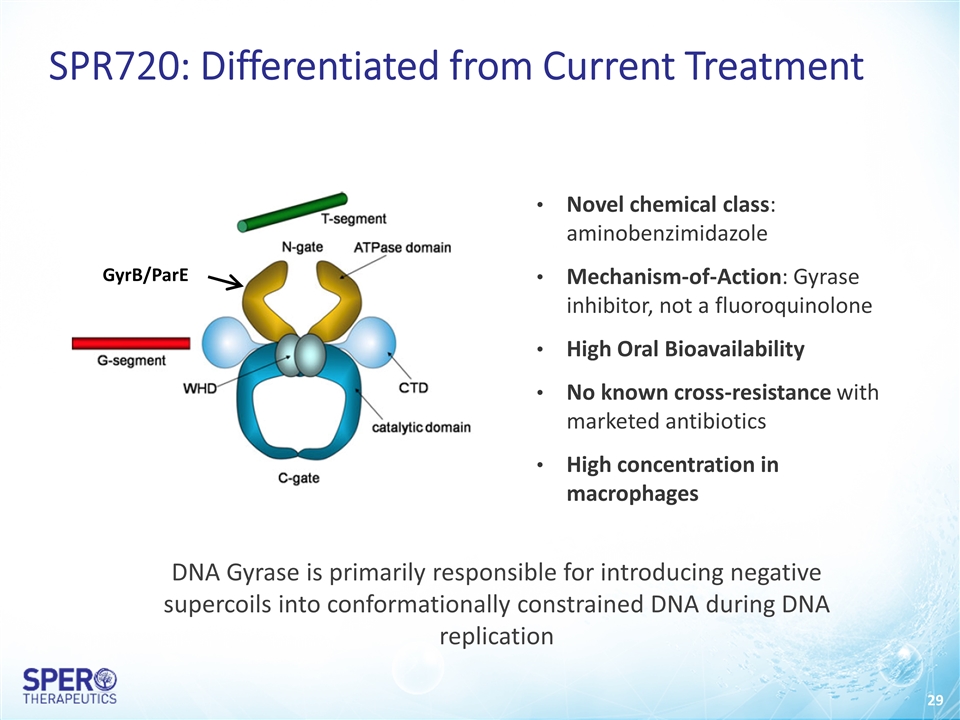
GyrB/ParE ATP DNA Gyrase is primarily responsible for introducing negative supercoils into conformationally constrained DNA during DNA replication SPR720: Differentiated from Current Treatment Novel chemical class: aminobenzimidazole Mechanism-of-Action: Gyrase inhibitor, not a fluoroquinolone High Oral Bioavailability No known cross-resistance with marketed antibiotics High concentration in macrophages
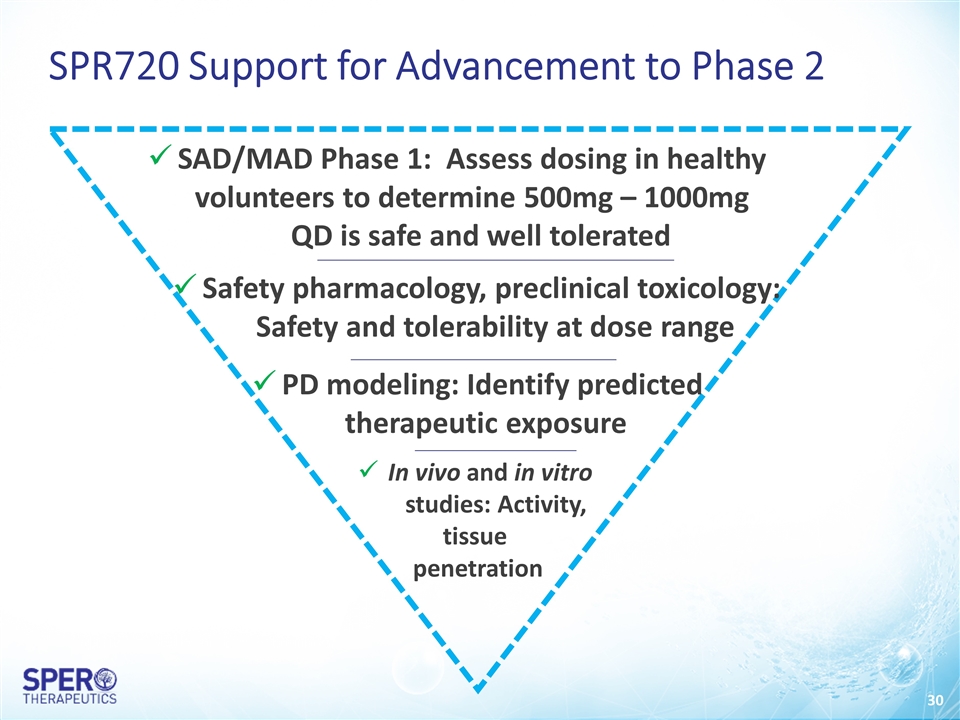
SPR720 Support for Advancement to Phase 2 In vivo and in vitro studies: Activity, tissue penetration PD modeling: Identify predicted therapeutic exposure Safety pharmacology, preclinical toxicology: Safety and tolerability at dose range SAD/MAD Phase 1: Assess dosing in healthy volunteers to determine 500mg – 1000mg QD is safe and well tolerated
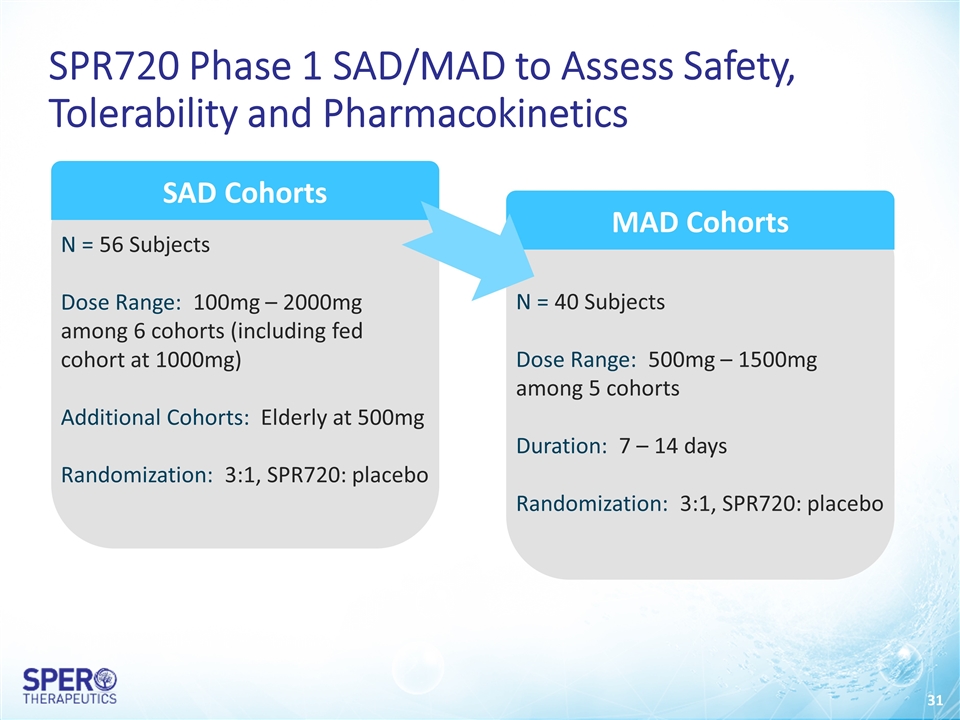
SPR720 Phase 1 SAD/MAD to Assess Safety, Tolerability and Pharmacokinetics N = 56 Subjects Dose Range: 100mg – 2000mg among 6 cohorts (including fed cohort at 1000mg) Additional Cohorts: Elderly at 500mg Randomization: 3:1, SPR720: placebo SAD Cohorts MAD Cohorts N = 40 Subjects Dose Range: 500mg – 1500mg among 5 cohorts Duration: 7 – 14 days Randomization: 3:1, SPR720: placebo
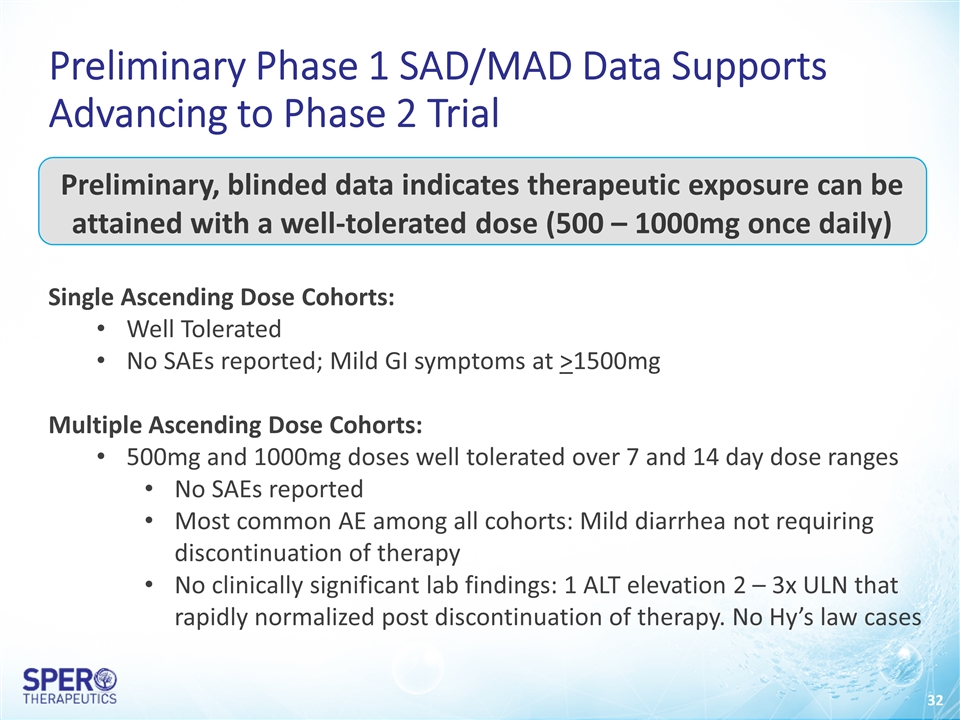
Preliminary Phase 1 SAD/MAD Data Supports Advancing to Phase 2 Trial Preliminary, blinded data indicates therapeutic exposure can be attained with a well-tolerated dose (500 – 1000mg once daily) Single Ascending Dose Cohorts: Well Tolerated No SAEs reported; Mild GI symptoms at >1500mg Multiple Ascending Dose Cohorts: 500mg and 1000mg doses well tolerated over 7 and 14 day dose ranges No SAEs reported Most common AE among all cohorts: Mild diarrhea not requiring discontinuation of therapy No clinically significant lab findings: 1 ALT elevation 2 – 3x ULN that rapidly normalized post discontinuation of therapy. No Hy’s law cases
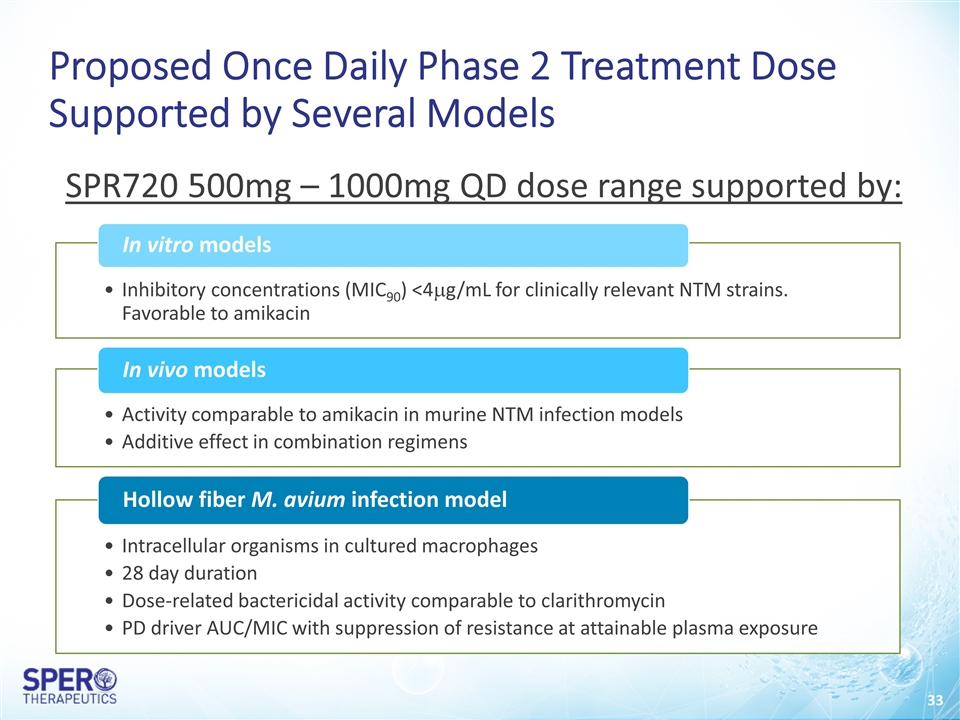
Proposed Once Daily Phase 2 Treatment Dose Supported by Several Models SPR720 500mg – 1000mg QD dose range supported by: In vitro models Inhibitory concentrations (MIC 90 ) <4 m g/mL for clinically relevant NTM strains. Favorable to amikacin In vivo models Activity comparable to amikacin in murine NTM infection models Additive effect in combination regimens Hollow fiber M. avium infection model Intracellular organisms in cultured macrophages 28 day duration Dose-related bactericidal activity comparable to clarithromycin PD driver AUC/MIC with suppression of resistance at attainable plasma exposure
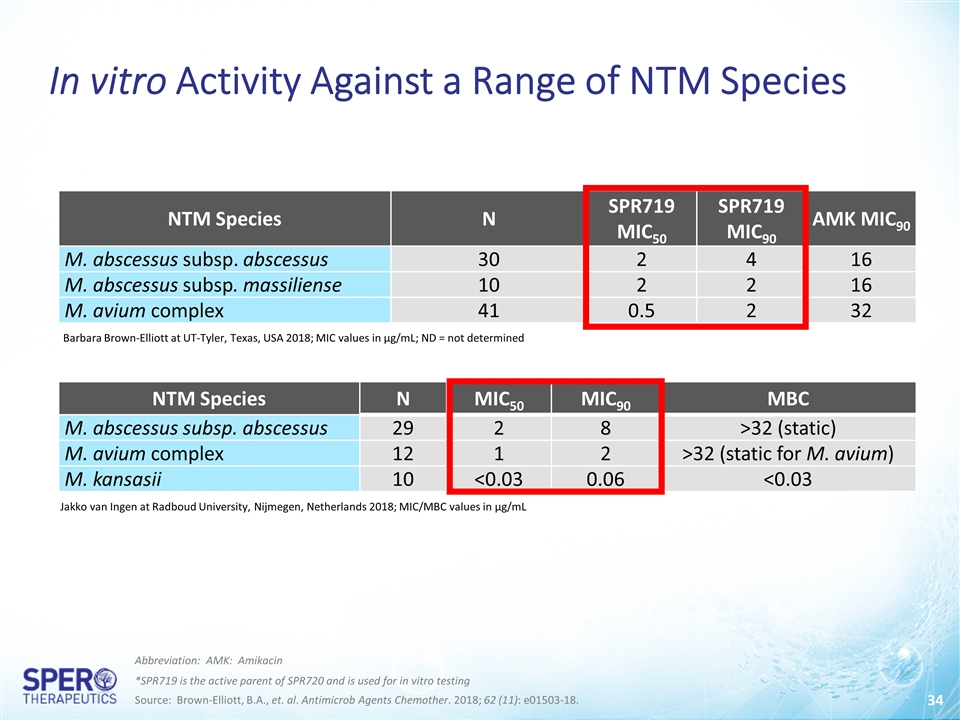
In vitro Activity Against a Range of NTM Species Abbreviation: AMK: Amikacin Source: Brown-Elliott, B.A., et. al. Antimicrob Agents Chemother. 2018; 62 (11): e01503-18. *SPR719 is the active parent of SPR720 and is used for in vitro testing NTM Species N SPR719 MIC50 SPR719 MIC90 AMK MIC90 M. abscessus subsp. abscessus 30 2 4 16 M. abscessus subsp. massiliense 10 2 2 16 M. avium complex 41 0.5 2 32 NTM Species N MIC50 MIC90 MBC M. abscessus subsp. abscessus 29 2 8 >32 (static) M. avium complex 12 1 2 >32 (static for M. avium) M. kansasii 10 <0.03 0.06 <0.03 Barbara Brown-Elliott at UT-Tyler, Texas, USA 2018; MIC values in μg/mL; ND = not determined Jakko van Ingen at Radboud University, Nijmegen, Netherlands 2018; MIC/MBC values in μg/mL
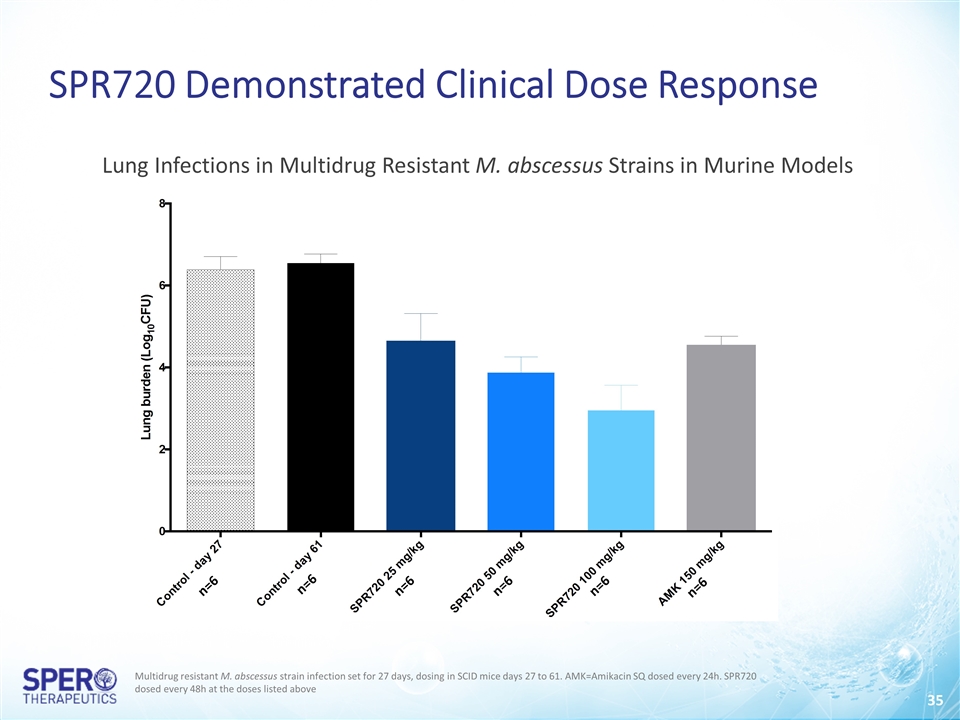
SPR720 Demonstrated Clinical Dose Response Multidrug resistant M. abscessus strain infection set for 27 days, dosing in SCID mice days 27 to 61. AMK=Amikacin SQ dosed every 24h. SPR720 dosed every 48h at the doses listed above Lung Infections in Multidrug Resistant M. abscessus Strains in Murine Models n=6 n=6 n=6 n=6 n=6 n=6
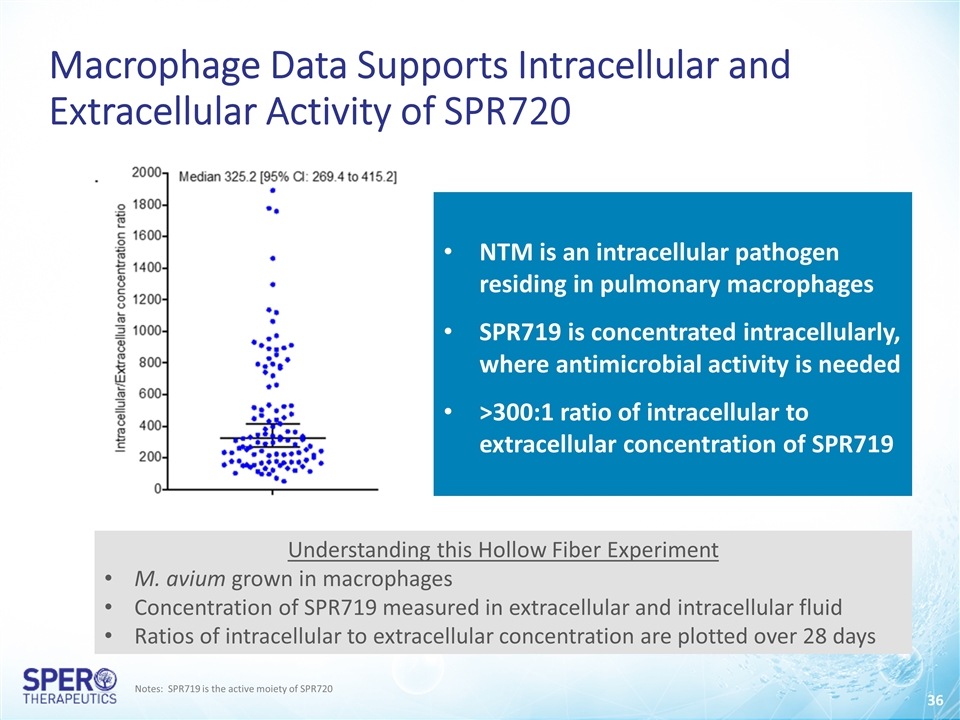
Macrophage Data Supports Intracellular and Extracellular Activity of SPR720 NTM is an intracellular pathogen residing in pulmonary macrophages SPR719 is concentrated intracellularly, where antimicrobial activity is needed >300:1 ratio of intracellular to extracellular concentration of SPR719 Understanding this Hollow Fiber Experiment M. avium grown in macrophages Concentration of SPR719 measured in extracellular and intracellular fluid Ratios of intracellular to extracellular concentration are plotted over 28 days Notes: SPR719 is the active moiety of SPR720
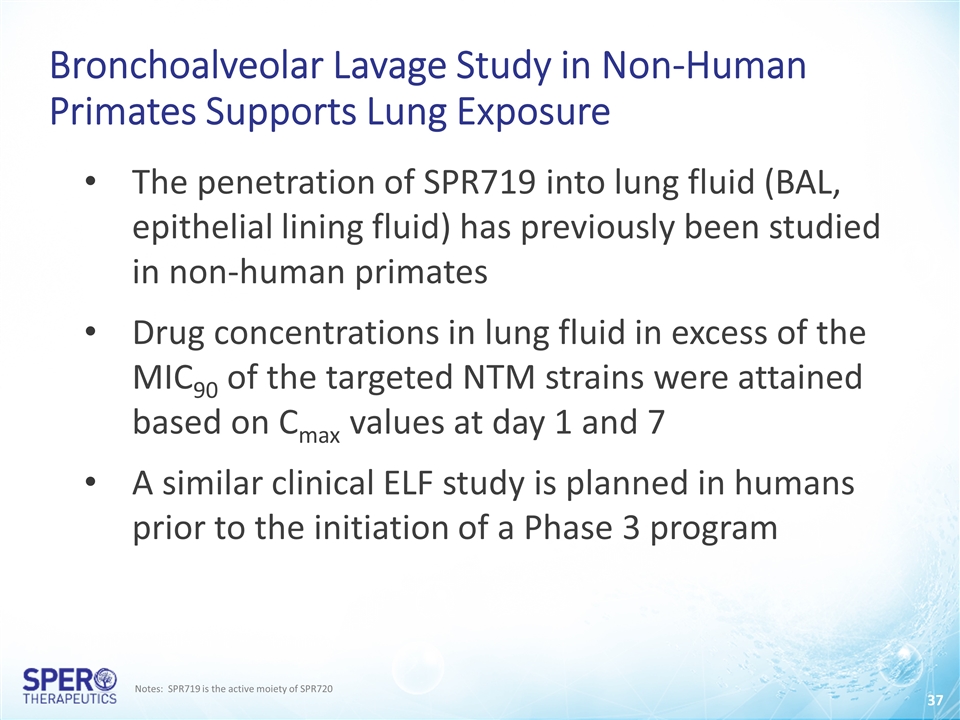
Bronchoalveolar Lavage Study in Non-Human Primates Supports Lung Exposure The penetration of SPR719 into lung fluid (BAL, epithelial lining fluid) has previously been studied in non-human primates Drug concentrations in lung fluid in excess of the MIC90 of the targeted NTM strains were attained based on Cmax values at day 1 and 7 A similar clinical ELF study is planned in humans prior to the initiation of a Phase 3 program Notes: SPR719 is the active moiety of SPR720
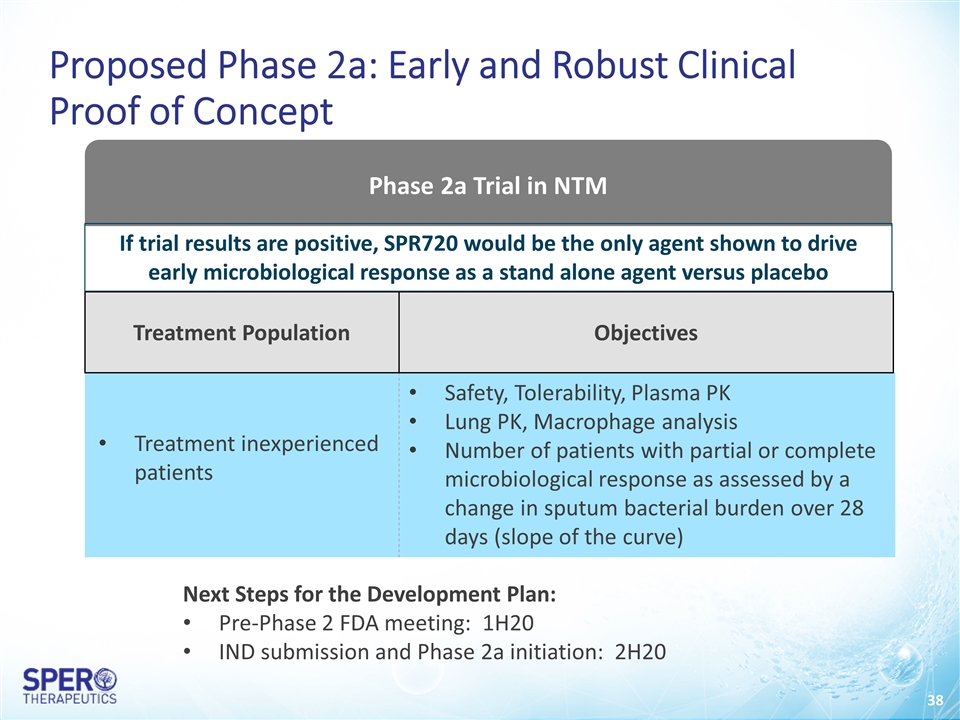
Proposed Phase 2a: Early and Robust Clinical Proof of Concept Phase 2a Trial in NTM Treatment Population Objectives Safety, Tolerability, Plasma PK Lung PK, Macrophage analysis Number of patients with partial or complete microbiological response as assessed by a change in sputum bacterial burden over 28 days (slope of the curve) Treatment inexperienced patients Next Steps for the Development Plan: Pre-Phase 2 FDA meeting: 1H20 IND submission and Phase 2a initiation: 2H20 If trial results are positive, SPR720 would be the only agent shown to drive early microbiological response as a stand alone agent versus placebo
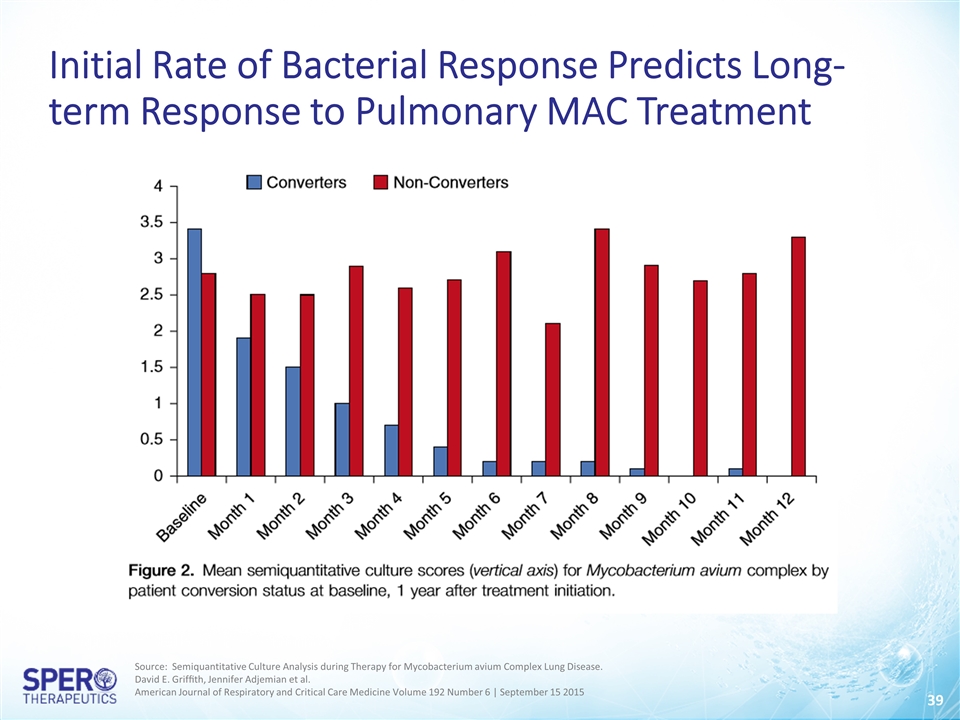
Initial Rate of Bacterial Response Predicts Long-term Response to Pulmonary MAC Treatment Source: Semiquantitative Culture Analysis during Therapy for Mycobacterium avium Complex Lung Disease. David E. Griffith, Jennifer Adjemian et al. American Journal of Respiratory and Critical Care Medicine Volume 192 Number 6 | September 15 2015
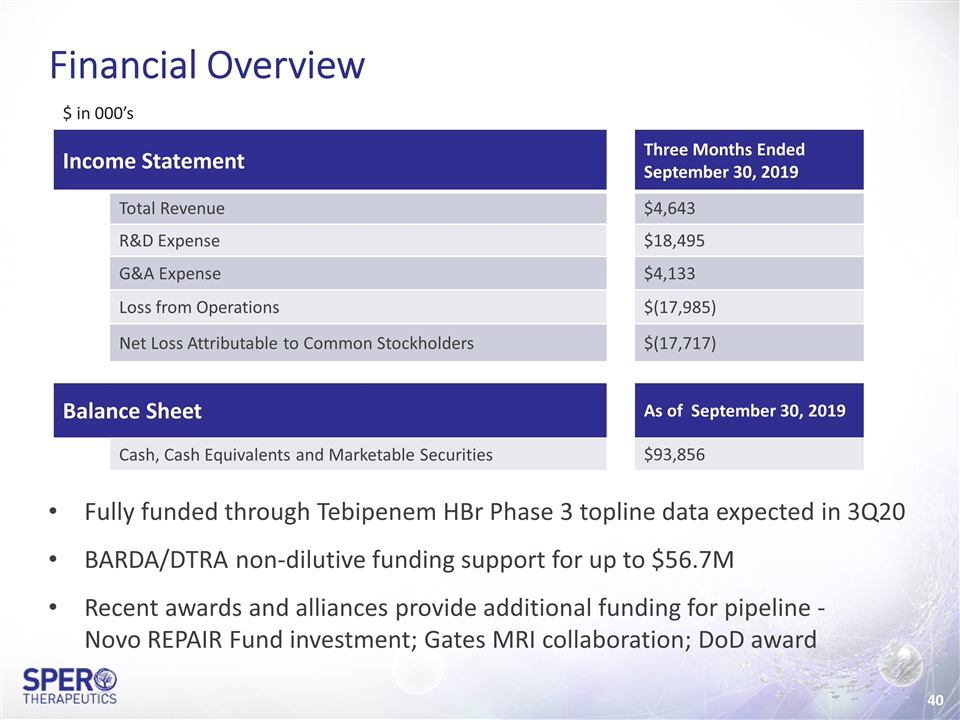
Financial Overview Fully funded through Tebipenem HBr Phase 3 topline data expected in 3Q20 BARDA/DTRA non-dilutive funding support for up to $56.7M Recent awards and alliances provide additional funding for pipeline - Novo REPAIR Fund investment; Gates MRI collaboration; DoD award $ in 000’s Income Statement Three Months Ended September 30, 2019 Total Revenue $4,643 R&D Expense $18,495 G&A Expense $4,133 Loss from Operations $(17,985) Net Loss Attributable to Common Stockholders $(17,717) Balance Sheet As of September 30, 2019 Cash, Cash Equivalents and Marketable Securities $93,856
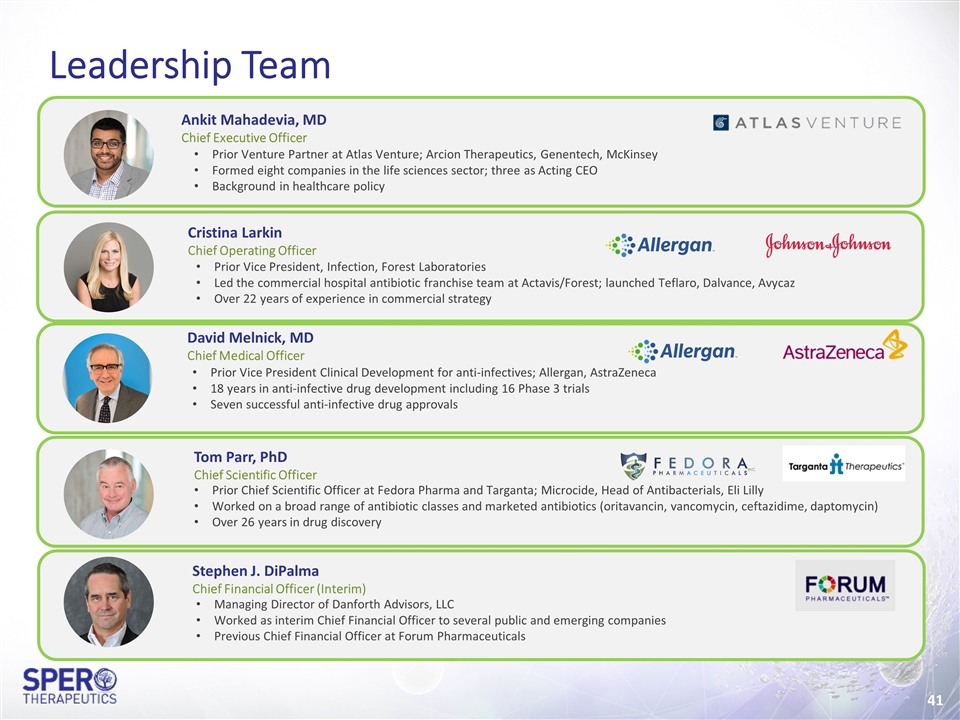
Leadership Team Prior Venture Partner at Atlas Venture; Arcion Therapeutics, Genentech, McKinsey Formed eight companies in the life sciences sector; three as Acting CEO Background in healthcare policy Ankit Mahadevia, MD Chief Executive Officer Prior Chief Scientific Officer at Fedora Pharma and Targanta; Microcide, Head of Antibacterials, Eli Lilly Worked on a broad range of antibiotic classes and marketed antibiotics (oritavancin, vancomycin, ceftazidime, daptomycin) Over 26 years in drug discovery Cristina Larkin Chief Operating Officer Managing Director of Danforth Advisors, LLC Worked as interim Chief Financial Officer to several public and emerging companies Previous Chief Financial Officer at Forum Pharmaceuticals Stephen J. DiPalma Chief Financial Officer (Interim) Prior Vice President Clinical Development for anti-infectives; Allergan, AstraZeneca 18 years in anti-infective drug development including 16 Phase 3 trials Seven successful anti-infective drug approvals David Melnick, MD Chief Medical Officer Prior Vice President, Infection, Forest Laboratories Led the commercial hospital antibiotic franchise team at Actavis/Forest; launched Teflaro, Dalvance, Avycaz Over 22 years of experience in commercial strategy Tom Parr, PhD Chief Scientific Officer
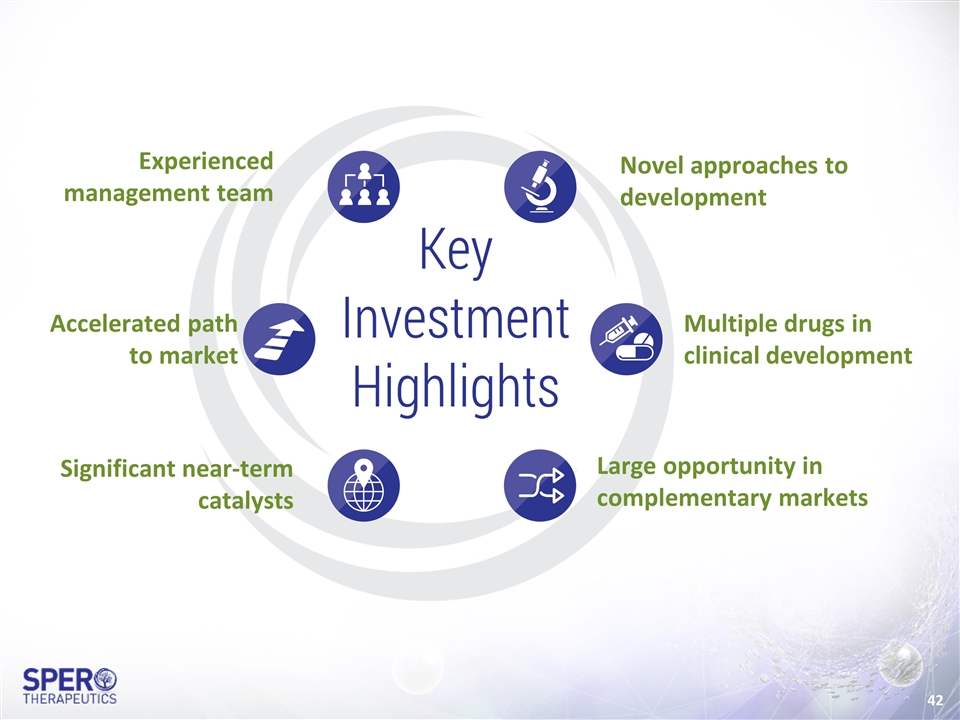
Experienced management team Multiple drugs in clinical development Large opportunity in complementary markets Significant near-term catalysts Accelerated path to market Novel approaches to development









































